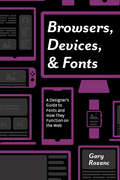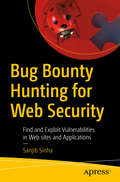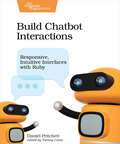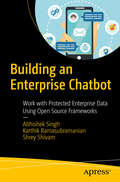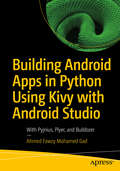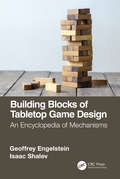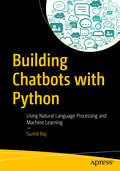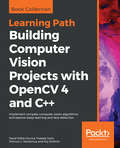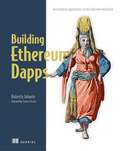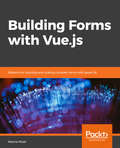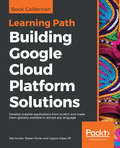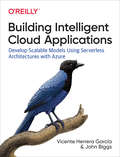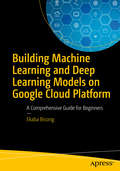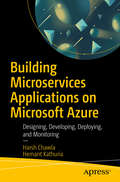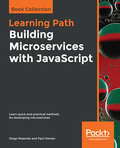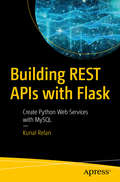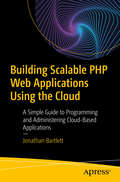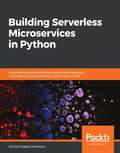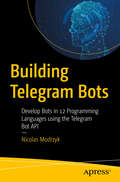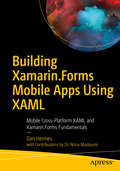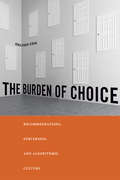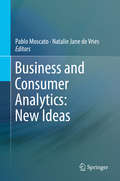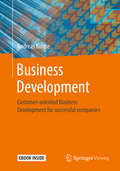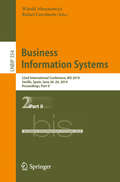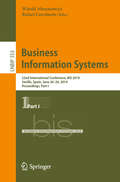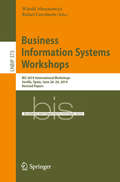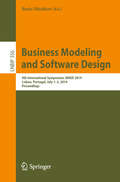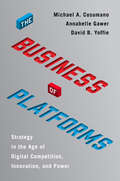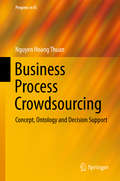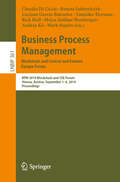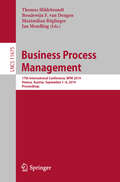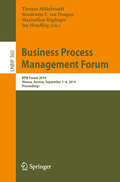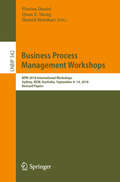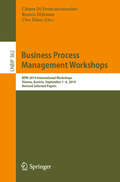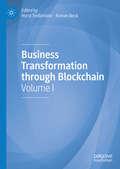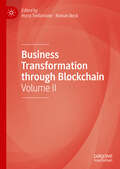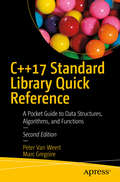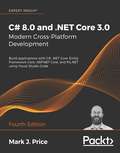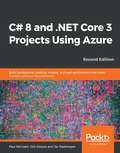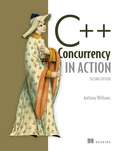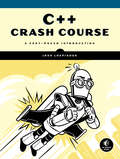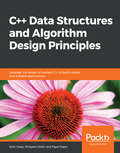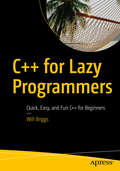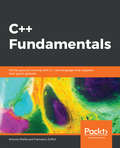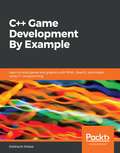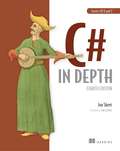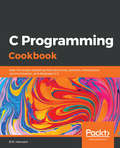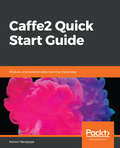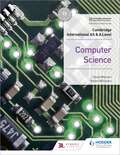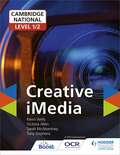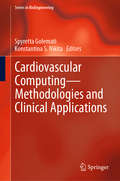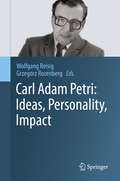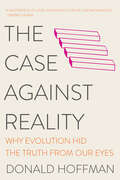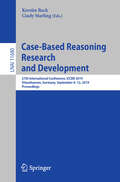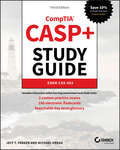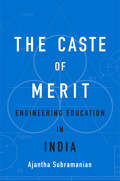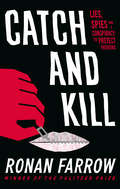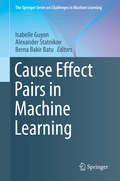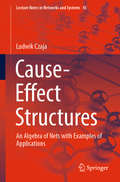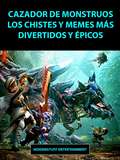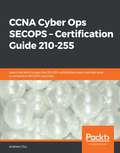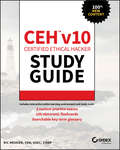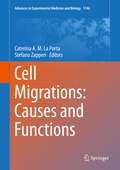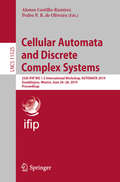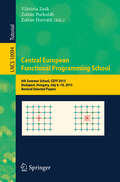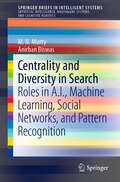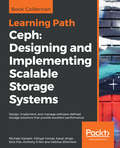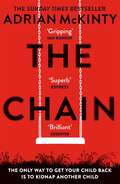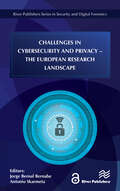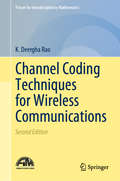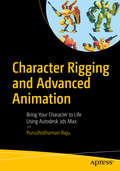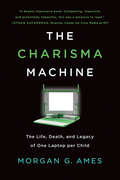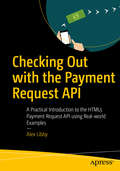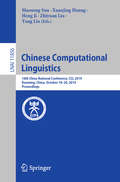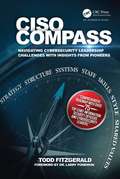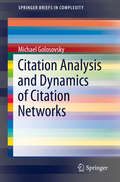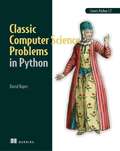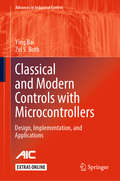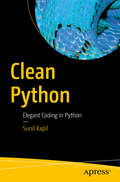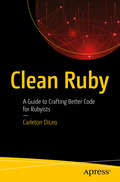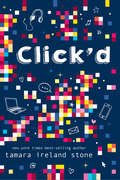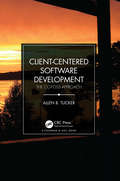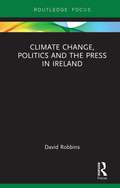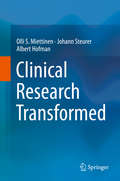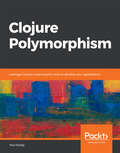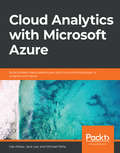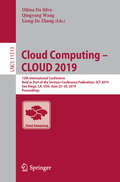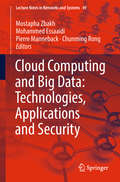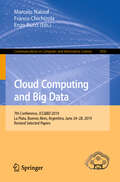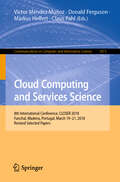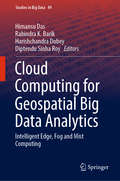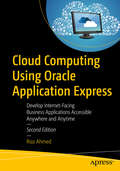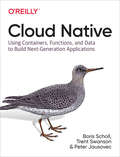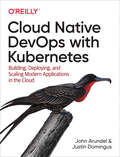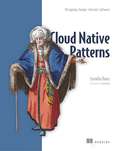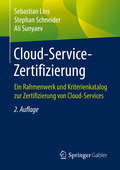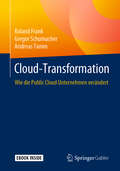- Table View
- List View
Browsers, Devices, and Fonts: A Designer's Guide to Fonts and How They Function on the Web
by Gary RozancPart technical and part theoretical, this practical guide to web typography helps designers understand how the typographic choices they make in layout and prototyping programs behave once they are turned into live code. Through a series of demos, this book teaches designers how to create typographic specific webpages by learning just enough HTML and CSS to be able to view the pages in different browsers, devices, and operating systems. With live webpages to evaluate, designers will learn how to test those pages for supported features and performance, ensuring font choices look as good in the browser as it does in their layout program, delivering a speedy experience to the users. Key Features Demonstrates the minimal amount of HTML and CSS necessary to be able to create webpages to see typographic choices in the browser. Discusses responsive design and how to evaluate and test those choices for performance and usability prior to front-end development. Demonstrates how to review your own typographic, image, and layout choices in the browser through a series of demos in the book.
Bug Bounty Hunting for Web Security: Find and Exploit Vulnerabilities in Web sites and Applications
by Sanjib SinhaStart with the basics of bug hunting and learn more about implementing an offensive approach by finding vulnerabilities in web applications. Getting an introduction to Kali Linux, you will take a close look at the types of tools available to you and move on to set up your virtual lab. You will then discover how request forgery injection works on web pages and applications in a mission-critical setup. Moving on to the most challenging task for any web application, you will take a look at how cross-site scripting works and find out about effective ways to exploit it. You will then learn about header injection and URL redirection along with key tips to find vulnerabilities in them. Keeping in mind how attackers can deface your website, you will work with malicious files and automate your approach to defend against these attacks. Moving on to Sender Policy Framework (SPF), you will see tips to find vulnerabilities in it and exploit them. Following this, you will get to know how unintended XML injection and command injection work to keep attackers at bay. Finally, you will examine different attack vectors used to exploit HTML and SQL injection. Overall, Bug Bounty Hunting for Web Security will help you become a better penetration tester and at the same time it will teach you how to earn bounty by hunting bugs in web applications. What You Will Learn Implement an offensive approach to bug hunting Create and manage request forgery on web pages Poison Sender Policy Framework and exploit it Defend against cross-site scripting (XSS) attacks Inject headers and test URL redirection Work with malicious files and command injectionResist strongly unintended XML attacks Who This Book Is ForWhite-hat hacking enthusiasts who are new to bug hunting and are interested in understanding the core concepts.
Build Chatbot Interactions: Responsive, Intuitive Interfaces with Ruby
by Daniel PritchettThe next step in the evolution of user interfaces is here. Chatbots let your users interact with your service in their own natural language. Use free and open source tools along with Ruby to build creative, useful, and unexpected interactions for users. Take advantage of the Lita framework's step-by-step implementation strategy to simplify bot development and testing. From novices to experts, chatbots are an area in which everyone can participate. Exercise your creativity by creating chatbot skills for communicating, information, and fun. Developers of all skill levels can craft user experiences that are natural, easy to use, and most of all, fun. Build chatbots using free, open source tools and launch them to popular chat platforms like Slack and Amazon's Alexa. Use the Ruby programming language and the Lita bot framework to unlock fun and powerful chat abilities such as sending text messages and emails, creating new meme images, driving a robot around the room, and talking out loud on a home speaker. Use frameworks available in Ruby and Node.js to get started quickly. Create simple chatbot skills that respond quickly to basic requests. Chain skills together for more complex interactions. Take advantage of test-driven development techniques to build your bots with confidence. Coordinate tasks with colleagues via bot. Connect with external APIs to provide users with data they need. Extract data information from web pages when an API isn't available. Expand your bot's reach with SMS and e-mail messaging. Deploy a chatbot to a host so users can interact with it on their schedule. Build a more responsive, easy-to-use interface for your users today. What You Need: You don't need much to get started with chatbots. A Mac or Linux computer with a recent version of Ruby is recommended. Windows users can keep up with a free virtual machine running Linux. You'll deploy your chatbots for free (or at least cheaply) on cloud hosting platforms like Heroku and Digital Ocean.
Building an Enterprise Chatbot: Work with Protected Enterprise Data Using Open Source Frameworks
by Abhishek Singh Karthik Ramasubramanian Shrey ShivamExplore the adoption of chatbots in business by focusing on the design, deployment, and continuous improvement of chatbots in a business, with a single use-case from the banking and insurance sector. This book starts by identifying the business processes in the banking and insurance industry. This involves data collection from sources such as conversations from customer service centers, online chats, emails, and other NLP sources. You’ll then design the solution architecture of the chatbot. Once the architecture is framed, the author goes on to explain natural language understanding (NLU), natural language processing (NLP), and natural language generation (NLG) with examples. In the next sections, you'll design and implement the backend framework of a typical chatbot from scratch. You will also explore some popular open-source chatbot frameworks such as Dialogflow and LUIS. The authors then explain how you can integrate various third-party services and enterprise databases with the custom chatbot framework. In the final section, you'll discuss how to deploy the custom chatbot framework on the AWS cloud.By the end of Building an Enterprise Chatbot, you will be able to design and develop an enterprise-ready conversational chatbot using an open source development platform to serve the end user.What You Will LearnIdentify business processes where chatbots could be usedFocus on building a chatbot for one industry and one use-case rather than building a ubiquitous and generic chatbot Design the solution architecture for a chatbotIntegrate chatbots with internal data sources using APIsDiscover the differences between natural language understanding (NLU), natural language processing (NLP), and natural language generation (NLG) Work with deployment and continuous improvement through representational learningWho This Book Is ForData scientists and enterprise architects who are currently looking to deploy chatbot solutions to their business.
Building Android Apps in Python Using Kivy with Android Studio: With Pyjnius, Plyer, and Buildozer
by Ahmed Fawzy GadStart building Python-based Android applications using Kivy with Android Studio. Through in-depth examples, this book teaches you everything you need to create your first Android application in Python and publish on Google Play.Building Android Apps in Python Using Kivy with Android Studio takes you through the basics of Kivy by discussing its application structure, widgets, and event handling. The KV language is then introduced for separating the logic and GUI by adding widgets within a KV file. You will then learn how to utilize Android camera using Kivy, build the HTTP server using Flask, and create and manage multiple screens to help you design your own applications. Through detailed step-by-step instructions, you will create your first multi-level cross-platform game that includes animation and sound effects. Following this, the process of converting the Kivy application into an Android application using Buildozer and Python-4-Android is covered in detail. You will then learn how to edit the generated Android Studio project into Android Studio by adding extensions to the original application. The widgets added in Kivy could be handled within Android Studio. Moreover, Android views could be added to enrich the Kivy application. The resulting Android application created with Kivy can be hosted on Google Play to download and install as a regular Android application.At the end, this book will give you the basic knowledge of Kivy needed to build cross-platform Android applications, produce an Android Studio project, and understand how it all works in detail. What You Will LearnBuild cross-platform applications from scratch using Kivy in detailCreate a cross-platform interactive multi-level game from the ground upExamine the pipeline of building an Android app from the Python Kivy appUnderstand the structure of the Android Studio project produced by KivyRecognize how to extend the application within Android Studio by adding more Android views to the application main activity. Who This Book Is ForPython developers with no previous experience in Kivy who are looking to create their first Android application completely in Python.
Building Blocks of Tabletop Game Design: An Encyclopedia of Mechanisms
by Geoffrey Engelstein Isaac ShalevBuilding Blocks of Tabletop Game Design: An Encyclopedia of Mechanisms compiles hundreds of different mechanisms, organized by category. Each has a description of how it works, discussion of its pros and cons, how it can be implemented, and examples of specific games that use it. Building Blocks can be read cover to cover, used as a reference when looking for inspiration for a new design, help solving a specific problem, or assist in getting unstuck in the midst of a project. This book, the first to collect mechanisms like this in the tabletop game design field, aims to be a practical guide that will be a great starting point for beginning designers, a handy guidebook for the experienced, and an ideal classroom textbook. Key Features The first compendium of its kind in the tabletop game field. Covers the nuts and bolts of design to resolve specific challenges. Serves as a practical guide, a great starting point for beginning designers, and a reference for seasoned professionals. Contains discussion of a series of standalone mechanisms, in a standard format and style, with cross-links to related mechanics and specific examples. Includes hundreds of mechanism entries with accompanying diagrams and sample games to study. Ideal for professional or classroom use.
Building Chatbots with Python: Using Natural Language Processing And Machine Learning
by Sumit RajBuild your own chatbot using Python and open source tools. This book begins with an introduction to chatbots where you will gain vital information on their architecture. You will then dive straight into natural language processing with the natural language toolkit (NLTK) for building a custom language processing platform for your chatbot. With this foundation, you will take a look at different natural language processing techniques so that you can choose the right one for you. The next stage is to learn to build a chatbot using the API.ai platform and define its intents and entities. During this example, you will learn to enable communication with your bot and also take a look at key points of its integration and deployment.The final chapter of Building Chatbots with Python teaches you how to build, train, and deploy your very own chatbot. Using open source libraries and machine learning techniques you will learn to predict conditions for your bot and develop a conversational agent as a web application. Finally you will deploy your chatbot on your own server with AWS. What You Will LearnGain the basics of natural language processing using Python Collect data and train your data for the chatbotBuild your chatbot from scratch as a web appIntegrate your chatbots with Facebook, Slack, and TelegramDeploy chatbots on your own serverWho This Book Is ForIntermediate Python developers who have no idea about chatbots. Developers with basic Python programming knowledge can also take advantage of the book.
Building Computer Vision Projects with OpenCV 4 and C++: Implement complex computer vision algorithms and explore deep learning and face detection
by David Millán Escrivá Prateek Joshi Vinícius G. Mendonça Roy ShilkrotDelve into practical computer vision and image processing projects and get up to speed with advanced object detection techniques and machine learning algorithmsKey FeaturesDiscover best practices for engineering and maintaining OpenCV projectsExplore important deep learning tools for image classificationUnderstand basic image matrix formats and filtersBook DescriptionOpenCV is one of the best open source libraries available and can help you focus on constructing complete projects on image processing, motion detection, and image segmentation.This Learning Path is your guide to understanding OpenCV concepts and algorithms through real-world examples and activities. Through various projects, you'll also discover how to use complex computer vision and machine learning algorithms and face detection to extract the maximum amount of information from images and videos. In later chapters, you'll learn to enhance your videos and images with optical flow analysis and background subtraction. Sections in the Learning Path will help you get to grips with text segmentation and recognition, in addition to guiding you through the basics of the new and improved deep learning modules. By the end of this Learning Path, you will have mastered commonly used computer vision techniques to build OpenCV projects from scratch. This Learning Path includes content from the following Packt books:Mastering OpenCV 4 - Third Edition by Roy Shilkrot and David Millán EscriváLearn OpenCV 4 By Building Projects - Second Edition by David Millán Escrivá, Vinícius G. Mendonça, and Prateek JoshiWhat you will learnStay up-to-date with algorithmic design approaches for complex computer vision tasksWork with OpenCV's most up-to-date API through various projectsUnderstand 3D scene reconstruction and Structure from Motion (SfM)Study camera calibration and overlay augmented reality (AR) using the ArUco moduleCreate CMake scripts to compile your C++ applicationExplore segmentation and feature extraction techniquesRemove backgrounds from static scenes to identify moving objects for surveillanceWork with new OpenCV functions to detect and recognize text with TesseractWho this book is forIf you are a software developer with a basic understanding of computer vision and image processing and want to develop interesting computer vision applications with OpenCV, this Learning Path is for you. Prior knowledge of C++ and familiarity with mathematical concepts will help you better understand the concepts in this Learning Path.
Building Ethereum Dapps: Decentralized applications on the Ethereum blockchain
by Roberto InfanteSummaryBuilding Ethereum Dapps introduces you to decentralized applications based on the Ethereum blockchain platform. In this book, you'll learn the principles of Dapps development by rolling up your sleeves and actually building a few!Foreword by Thomas Bertani.Purchase of the print book includes a free eBook in PDF, Kindle, and ePub formats from Manning Publications.About the TechnologyImagine unbreakably secure applications that handle personal and business transactions without any central agency controlling the process. Decentralized applications, or Dapps, do just this, shifting power to users. The Ethereum blockchain platform provides the tools you need to build Dapps, including an innovative "smart contracts" model and Solidity, a Dapp-aware JavaScript-like programming language.About the BookBuilding Ethereum Dapps teaches Dapps development on the Ethereum blockchain platform. You'll begin with a mental model of how Dapps operate, and then dive into designing and implementing smart contracts in Ethereum's Solidity language. You'll explore Ethereum smart contract development tools, like Truffle and Web3, and pick up best practices for design and security. Practical exercises throughout give you valuable hands-on experience. What's insideEthereum's key componentsImplementing smart contracts in SolidityCommunicating with a smart contract in Web3Developing Dapps with TruffleBest practices for design and security improvementAbout the ReaderFor developers with intermediate experience in JavaScript or an OO language. Familiarity with blockchain concepts is helpful.About the AuthorRoberto Infante is a software development consultant who specializes in finance. He currently works on financial risk management systems and on blockchain technology.Table of ContentsPART 1A first look at decentralized applicationsUnderstanding the blockchainThe Ethereum platformDeploying your first smart contractPART 2Programming smart contracts in SolidityWriting more complex smart contractsGeneralizing functionality with abstract contracts and interfacesManaging smart contracts with Web3.jsPART 3The Ethereum ecosystemUnit testing contracts with MochaImproving the development cycle with TrufflePutting it all together: Building a complete voting DappPART 4Making a Dapp production readySecurity considerationsConclusions
Building Forms with Vue.js: Patterns For Building And Scaling Complex Forms With Great Ux
by Marina MostiThis book is intended for any developer with basic Vue experience who wants to enhance their forms. No previous experience with any of the libraries used in the book is required.
Building Google Cloud Platform Solutions: Develop scalable applications from scratch and make them globally available in almost any language
by Ted Hunter Steven Porter Legorie Rajan PSBuild cost-effective and robust cloud solutions with Google Cloud Platform (GCP) using these simple and practical recipes Key Features Explore the various service offerings of the GCP Host a Python application on Google Compute Engine Securely maintain application states with Cloud Storage, Datastore, and Bigtable Book Description GCP is a cloud computing platform with a wide range of products and services that enable you to build and deploy cloud-hosted applications. This Learning Path will guide you in using GCP and designing, deploying, and managing applications on Google Cloud. You will get started by learning how to use App Engine to access Google's scalable hosting and build software that runs on this framework. With the help of Google Compute Engine, you'll be able to host your workload on virtual machine instances. The later chapters will help you to explore ways to implement authentication and security, Cloud APIs, and command-line and deployment management. As you hone your skills, you'll understand how to integrate your new applications with various data solutions on GCP, including Cloud SQL, Bigtable, and Cloud Storage. Following this, the book will teach you how to streamline your workflow with tools, including Source Repositories, Container Builder, and Stackdriver. You'll also understand how to deploy and debug services with IntelliJ, implement continuous delivery pipelines, and configure robust monitoring and alerts for your production systems. By the end of this Learning Path, you'll be well versed with GCP's development tools and be able to develop, deploy, and manage highly scalable and reliable applications. This Learning Path includes content from the following Packt products: Google Cloud Platform for Developers Ted Hunter and Steven Porter Google Cloud Platform Cookbook by Legorie Rajan PS What you will learn Host an application using Google Cloud Functions Migrate a MySQL database to Cloud Spanner Configure a network for a highly available application on GCP Learn simple image processing using Storage and Cloud Functions Automate security checks using Policy Scanner Deploy and run services on App Engine and Container Engine Minimize downtime and mitigate issues with Stackdriver Monitoring and Debugger Integrate with big data solutions, including BigQuery, Dataflow, and Pub/Sub Who this book is for This Learning Path is for IT professionals, engineers, and developers who want to implement Google Cloud in their organizations. Administrators and architects planning to make their organization more efficient with Google Cloud will also find this Learning Path useful. Basic understanding of GCP and its services is a must.
Building Intelligent Cloud Applications: Develop Scalable Models Using Serverless Architectures with Azure
by John Biggs Jose Luis Calvo Salanova Vicente GarcíaServerless computing is radically changing the way we build and deploy applications. With cloud providers running servers and managing machine resources, companies now can focus solely on the application’s business logic and functionality. This hands-on book shows experienced programmers how to build and deploy scalable machine learning and deep learning models using serverless architectures with Microsoft Azure.You’ll learn step-by-step how to code machine learning into your projects using Python and pre-trained models that include tools such as image recognition, speech recognition, and classification. You’ll also examine issues around deployment and continuous delivery including scaling, security, and monitoring.This book is divided into four parts:Cloud-based development: learn the basics of serverless computing with machine learning, functions as a service (FaaS), and the use of APIsAdding intelligence: create serverless applications using Azure Functions; learn how to use pre-built machine-learning and deep-learning modelsDeployment and continuous delivery: get up to speed with Azure Kubernetes Service, as well as Azure Security Center, and Azure MonitoringApplication examples: deliver data at the edge, build conversational interfaces, and use convolutional neural networks for image classification
Building Machine Learning and Deep Learning Models on Google Cloud Platform: A Comprehensive Guide for Beginners
by Ekaba BisongTake a systematic approach to understanding the fundamentals of machine learning and deep learning from the ground up and how they are applied in practice. You will use this comprehensive guide for building and deploying learning models to address complex use cases while leveraging the computational resources of Google Cloud Platform.Author Ekaba Bisong shows you how machine learning tools and techniques are used to predict or classify events based on a set of interactions between variables known as features or attributes in a particular dataset. He teaches you how deep learning extends the machine learning algorithm of neural networks to learn complex tasks that are difficult for computers to perform, such as recognizing faces and understanding languages. And you will know how to leverage cloud computing to accelerate data science and machine learning deployments.Building Machine Learning and Deep Learning Models on Google Cloud Platform is divided into eight parts that cover the fundamentals of machine learning and deep learning, the concept of data science and cloud services, programming for data science using the Python stack, Google Cloud Platform (GCP) infrastructure and products, advanced analytics on GCP, and deploying end-to-end machine learning solution pipelines on GCP.What You’ll Learn Understand the principles and fundamentals of machine learning and deep learning, the algorithms, how to use them, when to use them, and how to interpret your resultsKnow the programming concepts relevant to machine and deep learning design and development using the Python stackBuild and interpret machine and deep learning modelsUse Google Cloud Platform tools and services to develop and deploy large-scale machine learning and deep learning productsBe aware of the different facets and design choices to consider when modeling a learning problemProductionalize machine learning models into software products Who This Book Is For Beginners to the practice of data science and applied machine learning, data scientists at all levels, machine learning engineers, Google Cloud Platform data engineers/architects, and software developers
Building Microservices Applications on Microsoft Azure: Designing, Developing, Deploying, and Monitoring
by Harsh Chawla Hemant KathuriaImplement microservices starting with their architecture and moving on to their deployment, manageability, security, and monitoring. This book focuses on the key scenarios where microservices architecture is preferred over a monolithic architecture.Building Microservices Applications on Microsoft Azure begins with a survey of microservices architecture compared to monolithic architecture and covers microservices implementation in detail. You'll see the key scenarios where microservices architecture is preferred over a monolithic approach. From there, you will explore the critical components and various deployment options of microservices on platforms such as Microsoft Azure (public cloud) and Azure Stack (hybrid cloud). This includes in-depth coverage of developing, deploying, and monitoring microservices on containers and orchestrating with Azure Service Fabric and Azure Kubernetes Cluster (AKS).This book includes practical experience from large-scale enterprise deployments, therefore it can be a quick reference for solution architects and developers to understand the critical factors while designing a microservices application. What You Will LearnExplore the use cases of microservices and monolithic architectureDiscover the architecture patterns to build scalable, agile, and secure microservices applicationsDevelop and deploy microservices using Azure Service Fabric and Azure Kubernetes Service Secure microservices using the gateway patternSee the deployment options for Microservices on Azure StackImplement database patterns to handle the complexities introduced by microservices Who This Book Is ForArchitects and consultants who work on Microsoft Azure and manage large-scale deployments.
Building Microservices with JavaScript: Learn quick and practical methods for developing microservices
by Diogo Resende Paul OsmanExplore microservices by developing with Express, deploying with Docker, and scaling with Swarm and Kubernetes.Key FeaturesBuild cloud-native microservices using only Node and ExpressWrite clean and maintainable code with JavaScript for improved microservices developmentLearn ways to monitor and manage your services in a production environmentBook DescriptionMicroservices are a popular way to build distributed systems that power modern web and mobile apps. With the help of this Learning Path, you'll learn how to develop your applications as a suite of independently deployable and scalable services.Using an example-driven approach, this Learning Path will uncover how you can dismantle your monolithic application and embrace microservice architecture, right from architecting your services and modeling them to integrating them into your application. You’ll also explore ways to overcome challenges in testing and deploying these services by setting up deployment pipelines that break down the application development process into several stages. You’ll study serverless architecture for microservices and understand its benefits. Furthermore, this Learning Path delves into the patterns used for organizing services, helping you optimize request handling and processing. You'll then move on to learn the fault-tolerance and reliability patterns that help you use microservices to isolate failures in your applications.By the end of this Learning Path, you’ll have the skills necessary to build enterprise-ready applications using microservices.This Learning Path includes content from the following Packt products:Hands-On Microservices with Node.js by Diogo ResendeMicroservices Development Cookbook by Paul OsmanWhat you will learnUse Docker and Swarm for continuous deployment and scalingBuild and deploy cloud-native microservices and avoid vendor lock-inExplore different service architectures such as Hydra and SenecaCreate services that don’t impact users upon failureMonitor your services to perform debugging and create observable systemsDevelop fast and reliable deployment pipelinesManage multiple environments for your servicesSimplify the local development of microservice-based systemsWho this book is forIf you’re a JavaScript developer looking to put your skills to work by building microservices and moving away from the monolithic architecture, this book is for you. To understand the concepts explained in this Learning Path, you must have knowledge of Node.js and be familiar with the microservices architecture.
Building REST APIs with Flask: Create Python Web Services with MySQL
by Kunal RelanDevelop RESTful web services using the Flask micro-framework and integrate them using MySQL. Use Flask to develop, deploy, and manage REST APIs with easy-to-read and understand Python code. Solve your problem from a choice of libraries. Learn to use MySQL as the web services database for your Flask API using SQLAlchemy ORM.Building REST APIs with Flask provides a primer on Flask, RESTful services, and working with pip to set up your virtual environment. The key differences between NoSQL and SQL are covered, and you are taught how to connect MySQL and Flask using SQLAlchemy. Author Kunal Relan presents best practices for creating REST APIs and guides you in structuring your app and testing REST endpoints. He teaches you how to set up authentication and render HTML using views. You learn how to write unit tests for your REST APIs, and understand mocks, assertions, and integration testing. You will know how to document your REST APIs, deploy your Flask application on all of the major cloud platforms, and debug and monitor your Flask application.What You'll LearnUse MySQL to create Flask REST APIs Test REST endpointsCreate CRUD endpoints with Flask and MySQLDeploy Flask on all of the major cloud platformsMonitor your Flask application Who This Book Is For Python developers interested in REST API development using Flask and web developers with basic programming knowledge who want to learn how Python and REST APIs work together. Readers should be familiar with Python (command line, or at least pip) and MySQL.
Building Scalable PHP Web Applications Using the Cloud: A Simple Guide to Programming and Administering Cloud-Based Applications
by Jonathan BartlettEliminate the guesswork involved in writing and deploying a cloud application. This step-by-step guide uses PHP to minimize the complexity of the code and setup, but the tools and techniques can be applied on any platform using any language. Everything that you need to jumpstart your application on the cloud is right here.Clear diagrams, step-by-step configuration information, and complete code listings tell you everything you need to get off the ground and start developing your cloud application today. This book introduces several cloud architectures and technologies that will help you accelerate your application in the cloud. Chapters cover load-balanced clusters, database replication, caching configuration, content delivery networks, infinite-scale file storage, and cloud system administration. Cloud computing has dramatically changed the landscape of web hosting. Instead of spending weeks negotiating contracts for servers, new servers can be deployed with the push of a button, and your application can be resized almost instantly to meet today's needs. No matter what size of web application you are developing, you can benefit from modern cloud servers, and this is the guide to tell you how. What You'll LearnUse the cloud and its various platforms with Docker management toolsBuild a simple PHP-based scalable web applicationCreate a basic cloud clusterWork with Amazon and Google Cloud Platform in your PHP web application developmentWho This Book Is ForDevelopers who have some prior programming experience, including PHP, and who are new to building applications
Building Serverless Microservices in Python: A complete guide to building, testing, and deploying microservices using serverless computing on AWS
by Richard Takashi FreemanA practical guide for developing end-to-end serverless microservices in Python for developers, DevOps, and architects. Key Features Create a secure, cost-effective, and scalable serverless data API Use identity management and authentication for a user-specific and secure web application Go beyond traditional web hosting to explore the full range of cloud hosting options Book Description Over the last few years, there has been a massive shift from monolithic architecture to microservices, thanks to their small and independent deployments that allow increased flexibility and agile delivery. Traditionally, virtual machines and containers were the principal mediums for deploying microservices, but they involved a lot of operational effort, configuration, and maintenance. More recently, serverless computing has gained popularity due to its built-in autoscaling abilities, reduced operational costs, and increased productivity. Building Serverless Microservices in Python begins by introducing you to serverless microservice structures. You will then learn how to create your first serverless data API and test your microservice. Moving on, you'll delve into data management and work with serverless patterns. Finally, the book introduces you to the importance of securing microservices. By the end of the book, you will have gained the skills you need to combine microservices with serverless computing, making their deployment much easier thanks to the cloud provider managing the servers and capacity planning. What you will learn Discover what microservices offer above and beyond other architectures Create a serverless application with AWS Gain secure access to data and resources Run tests on your configuration and code Create a highly available serverless microservice data API Build, deploy, and run your serverless configuration and code Who this book is for If you are a developer with basic knowledge of Python and want to learn how to build, test, deploy, and secure microservices, then this book is for you. No prior knowledge of building microservices is required.
Building Telegram Bots: Develop Bots in 12 Programming Languages using the Telegram Bot API
by Nicolas ModrzykLearn about bot programming, using all the latest and greatest programming languages, including Python, Go, and Clojure, so you can feel at ease writing your Telegram bot in a way that suits you.This book shows how you can use bots for just about everything: they connect, they respond, they enhance your job search chances, they do technical research for you, they remind you about your last train, they tell the difference between a horse and a zebra, they can tell jokes, and they can cheer you up in the middle of the night. Bots used to be hard to set up and enhance, but with the help of Building Telegram Bots you’ll see how the Telegram platform is now making bot creation easier than ever. You will begin by writing a simple bot at the start and then gradually build upon it. The simple yet effective Telegram Bot API makes it very easy to develop bots in a number of programming languages. Languages featured in the book include Node.js, Java, Rust, and Elixir. This book encourages you to not only learn the basic process of creating a bot but also lets you spend time exploring its possibilities. By the end of the book you will be able create your own Telegram Bot with the programming language of your choice. What You Will LearnCarry out simple bot design and deployment in various programming languages including Ruby, D, Crystal, Nim, and C++Create engaging bot interactions with your usersAdd payments and media capabilities to your botsMaster programming language abstractionWho This Book Is ForEngineers who want to get things done. People who are curious. Programming beginners. Advanced engineers with little time to do research.
Building Xamarin.Forms Mobile Apps Using XAML: Mobile Cross-Platform XAML and Xamarin.Forms Fundamentals
by Dan Hermes Nima MazloumiLeverage Xamarin.Forms to build iOS and Android apps using a single, cross-platform approach. This book is the XAML companion to the C# guide Xamarin Mobile Application Development. You'll begin with an overview of Xamarin.Forms, then move on to an in-depth XAML (eXtensible Application Markup Language) primer covering syntax, namespaces, markup extensions, constructors, and the XAML standard. XAML gives us both the power of decoupled UI development and the direct use of Xamarin.Forms elements. This book explores the core of the Xamarin.Forms mobile app UI: using layouts and FlexLayouts to position controls and views to design and build screens, formatting your UI using resource dictionaries, styles, themes and CSS, then coding user interactions with behaviors, commands, and triggers. You'll see how to use XAML to build sophisticated, robust cross-platform mobile apps and help your user get around your app using Xamarin.Forms navigation patterns. Building Xamarin.Forms Mobile Apps Using XAML explains how to bind UI to data models using data binding and using the MVVM pattern, and how to customize UI elements for each platform using industry-standard menus, effects, custom renderers, and native view declaration. What You Will LearnCreat world-class mobile apps for iOS and Android using C# and XAMLBuild a UI decoupled from C# code and XAML Design UI layouts such as FrameLayout, controls, lists, and navigation patterns Style your app using resource dictionaries, styles, themes, and CSS Customize controls to have platform-specific features using effects, custom renderers, and native views Who This Book Is For XAML and C# developers, architects, and technical managers as well as many Android and iOS developers
The Burden of Choice: Recommendations, Subversion, and Algorithmic Culture
by Jonathan CohnThe Burden of Choice examines how recommendations for products, media, news, romantic partners, and even cosmetic surgery operations are produced and experienced online. Fundamentally concerned with how the recommendation has come to serve as a form of control that frames a contemporary American as heteronormative, white, and well off, this book asserts that the industries that use these automated recommendations tend to ignore and obscure all other identities in the service of making the type of affluence they are selling appear commonplace. Focusing on the period from the mid-1990s to approximately 2010 (while this technology was still novel), Jonathan Cohn argues that automated recommendations and algorithms are far from natural, neutral, or benevolent. Instead, they shape and are shaped by changing conceptions of gender, sexuality, race, and class. With its cultural studies and humanities-driven methodologies focused on close readings, historical research, and qualitative analysis, The Burden of Choice models a promising avenue for the study of algorithms and culture.
Business and Consumer Analytics: New Ideas
by Pablo Moscato Natalie Jane de VriesThis two-volume handbook presents a collection of novel methodologies with applications and illustrative examples in the areas of data-driven computational social sciences. Throughout this handbook, the focus is kept specifically on business and consumer-oriented applications with interesting sections ranging from clustering and network analysis, meta-analytics, memetic algorithms, machine learning, recommender systems methodologies, parallel pattern mining and data mining to specific applications in market segmentation, travel, fashion or entertainment analytics. A must-read for anyone in data-analytics, marketing, behavior modelling and computational social science, interested in the latest applications of new computer science methodologies.The chapters are contributed by leading experts in the associated fields.The chapters cover technical aspects at different levels, some of which are introductory and could be used for teaching. Some chapters aim at building a common understanding of the methodologies and recent application areas including the introduction of new theoretical results in the complexity of core problems. Business and marketing professionals may use the book to familiarize themselves with some important foundations of data science. The work is a good starting point to establish an open dialogue of communication between professionals and researchers from different fields.Together, the two volumes present a number of different new directions in Business and Customer Analytics with an emphasis in personalization of services, the development of new mathematical models and new algorithms, heuristics and metaheuristics applied to the challenging problems in the field. Sections of the book have introductory material to more specific and advanced themes in some of the chapters, allowing the volumes to be used as an advanced textbook. Clustering, Proximity Graphs, Pattern Mining, Frequent Itemset Mining, Feature Engineering, Network and Community Detection, Network-based Recommending Systems and Visualization, are some of the topics in the first volume. Techniques on Memetic Algorithms and their applications to Business Analytics and Data Science are surveyed in the second volume; applications in Team Orienteering, Competitive Facility-location, and Visualization of Products and Consumers are also discussed. The second volume also includes an introduction to Meta-Analytics, and to the application areas of Fashion and Travel Analytics. Overall, the two-volume set helps to describe some fundamentals, acts as a bridge between different disciplines, and presents important results in a rapidly moving field combining powerful optimization techniques allied to new mathematical models critical for personalization of services. Academics and professionals working in the area of business anyalytics, data science, operations research and marketing will find this handbook valuable as a reference. Students studying these fields will find this handbook useful and helpful as a secondary textbook.
Business Development: Customer-oriented Business Development for successful companies
by Andreas KohneThe book provides a compact overview of the increasingly important topic of Business Development (BD). The author not only describes the role of the Business Development Manager and its tasks, but also shows how Business Development can be integrated organizationally into a company. In addition, a prototypical Business Development Process is presented in concrete terms and explained using a case study. The book shows why enterprises fail, deals with new creative techniques such as Hackthons and dedicates itself more comprehensively than so far to the topic of communication in the course of changes.The book helps all, which want to introduce and/or optimize Business Development in the enterprise as responsible ones or work in the future in this range.
Business Information Systems: 22nd International Conference, BIS 2019, Seville, Spain, June 26–28, 2019, Proceedings, Part II (Lecture Notes in Business Information Processing #354)
by Witold Abramowicz Rafael CorchueloThe two-volume set LNBIP 353 and 354 constitutes the proceedings of the 22nd International Conference on Business Information Systems, BIS 2019, held in Seville, Spain, in June 2019. The theme of the BIS 2019 was "Data Science for Business Information Systems", inspiring researchers to share theoretical and practical knowledge of the different aspects related to Data Science in enterprises. The 67 papers presented in these proceedings were carefully reviewed and selected from 223 submissions. The contributions were organized in topical sections as follows: Part I: Big Data and Data Science; Artificial Intelligence; ICT Project Management; and Smart Infrastructure. Part II: Social Media and Web-based Systems; and Applications, Evaluations and Experiences.
Business Information Systems: 22nd International Conference, BIS 2019, Seville, Spain, June 26–28, 2019, Proceedings, Part I (Lecture Notes in Business Information Processing #353)
by Witold Abramowicz Rafael CorchueloThe two-volume set LNBIP 353 and 354 constitutes the proceedings of the 22nd International Conference on Business Information Systems, BIS 2019, held in Seville, Spain, in June 2019. The theme of the BIS 2019 was "Data Science for Business Information Systems", inspiring researchers to share theoretical and practical knowledge of the different aspects related to Data Science in enterprises. The 67 papers presented in these proceedings were carefully reviewed and selected from 223 submissions. The contributions were organized in topical sections as follows: Part I: Big Data and Data Science; Artificial Intelligence; ICT Project Management; and Smart Infrastructure. Part II: Social Media and Web-based Systems; and Applications, Evaluations and Experiences.
Business Information Systems Workshops: BIS 2019 International Workshops, Seville, Spain, June 26–28, 2019, Revised Papers (Lecture Notes in Business Information Processing #373)
by Witold Abramowicz Rafael CorchueloThis book constitutes revised papers from the nine workshops and one accompanying event which took place at the 22nd International Conference on Business Information Systems, BIS 2019, held in Seville, Spain, in June 2019. There was a total of 139 submissions to all workshops of which 57 papers were accepted for publication. The workshops included in this volume are: AKTB 2019: 11th Workshop on Applications of Knowledge-Based Technologies in Business BITA 2019: 10th Workshop on Business and IT Alignment BSCT 2019: Second Workshop on Blockchain and Smart Contract Technologies DigEX 2019: First International Workshop on transforming the Digital Customer Experience iCRM 2019: 4th International Workshop on Intelligent Data Analysis in Integrated Social CRM iDEATE 2019: 4th Workshop on Big Data and Business Analytics Ecosystems ISMAD 2019: Workshop on Information Systems and Applications in Maritime Domain QOD 2019: Second Workshop on Quality of Open Data SciBOWater 2019: Second Workshop on Scientific Challenges and Business Opportunities in Water Management
Business Modeling and Software Design: 9th International Symposium, BMSD 2019, Lisbon, Portugal, July 1–3, 2019, Proceedings (Lecture Notes in Business Information Processing #356)
by Boris ShishkovThis book constitutes the refereed proceedings of the 9th International Symposium on Business Modeling and Software Design, BMSD 2019, held in Lisbon, Portugal, in July 2019. It contains 12 full and 11 short papers. BMSD is a leading international forum that brings together researchers and practitioners interested in business modeling and its relation to software design. Particular areas of interest are: Business Processes and Enterprise Engineering; Business Models and Requirements; Business Models and Services; Business Models and Software; Information Systems Architectures and Paradigms; Data Aspects in Business Modeling and Software Development; Blockchain-Based Business Models and Information Systems; IoT and Implications for Enterprise Information Systems. The theme of BMSD 2019 was: REFLECTING HUMAN AUTHORITY AND RESPONSIBILITY IN ENTERPRISE MODELS AND SOFTWARE SPECIFICATIONS.
The Business of Platforms: Strategy in the Age of Digital Competition, Innovation, and Power
by David B. Yoffie Michael A. Cusumano Annabelle GawerA trio of experts on high-tech business strategy and innovation reveal the principles that have made platform businesses the most valuable firms in the world and the first trillion-dollar companies. Managers and entrepreneurs in the digital era must learn to live in two worlds—the conventional economy and the platform economy. Platforms that operate for business purposes usually exist at the level of an industry or ecosystem, bringing together individuals and organizations so they can innovate and interact in ways not otherwise possible. Platforms create economic value far beyond what we see in conventional companies.The Business of Platforms is an invaluable, in-depth look at platform strategy and digital innovation. Cusumano, Gawer, and Yoffie address how a small number of companies have come to exert extraordinary influence over every dimension of our personal, professional, and political lives. They explain how these new entities differ from the powerful corporations of the past. They also question whether there are limits to the market dominance and expansion of these digital juggernauts. Finally, they discuss the role governments should play in rethinking data privacy laws, antitrust, and other regulations that could reign in abuses from these powerful businesses. Their goal is to help managers and entrepreneurs build platform businesses that can stand the test of time and win their share of battles with both digital and conventional competitors. As experts who have studied and worked with these firms for some thirty years, this book is the most authoritative and timely investigation yet of the powerful economic and technological forces that make platform businesses, from Amazon and Apple to Microsoft, Facebook, and Google—all dominant players in shaping the global economy, the future of work, and the political world we now face.
Business Process Crowdsourcing: Concept, Ontology And Decision Support (Progress in IS)
by Nguyen Hoang ThuanThis book conceptualises and develops crowdsourcing as an organisational business process. It argues that although for many organisations crowdsourcing still implies an immature one-off endeavour, when developed to a more repeatable business process it can harness innovation and agility. The book offers a process model to guide organisations towards the establishment of business process crowdsourcing (BPC), and empirically showcases and evaluates the model using two current major crowdsourcing projects. In order to consolidate the domain knowledge, the BPC model is turned into a heavyweight ontology capturing the concepts, hierarchical relationships and decision-making relationships necessary to establish crowdsourcing as a business process in an organisation. Lastly, based on the ontology it presents a decision tool that provides advice on making informed decisions about the performance of business process crowdsourcing activities.
Business Process Management: BPM 2019 Blockchain and CEE Forum, Vienna, Austria, September 1–6, 2019, Proceedings (Lecture Notes in Business Information Processing #361)
by Claudio Di Ciccio Renata Gabryelczyk Luciano García-Bañuelos Tomislav Hernaus Rick Hull Mojca Indihar Štemberger Andrea Kő Mark StaplesThis book constitutes the contributions presented at the Blockchain Forum and the Central and Eastern Europe Forum (CEE Forum) held at the 17th International Conference on Business Process Management, BPM 2019, which took place in Vienna, Austria, in September 2019.The Blockchain Forum deals with the use of blockchain for collaborative information systems. Conceptual, technical and application-oriented contributions are pursued within the scope of this theme. The Blockchain Forum received a total of 31 submissions; 10 full and 1 short paper were accepted for publication in this book. The objective of the CEE Forum is to foster discussion for BPM academics from Central and Eastern Europe to disseminate their research, compare results and share experiences. For the CEE Forum 16 submissions were received and 6 full and 2 short papers were accepted for publication.The book also contains one invited talk in full-paper length and 6 poster papers from the CEE Forum.
Business Process Management: 17th International Conference, BPM 2019, Vienna, Austria, September 1–6, 2019, Proceedings (Lecture Notes in Computer Science #11675)
by Thomas Hildebrandt Boudewijn F. van Dongen Maximilian Röglinger Jan MendlingThis book constitutes the proceedings of the 17th International Conference on Business Process Management, BPM 2019, held in Vienna, Austria, in September 2019. The 23 full and 4 tutorial short papers included in this volume were carefully reviewed and selected from 115 submissions. The papers were organized in topical sections named: foundations; engineering; and management.
Business Process Management Forum: BPM Forum 2019, Vienna, Austria, September 1–6, 2019, Proceedings (Lecture Notes in Business Information Processing #360)
by Thomas Hildebrandt Boudewijn F. van Dongen Maximilian Röglinger Jan MendlingThis book constitutes the proceedings of the BPM Forum held during the 17th International Conference on Business Process Management, BPM 2019, which took place in Vienna, Austria, in September 2019. The BPM Forum hosts innovative research which has a high potential of stimulating discussions. The papers selected for the forum are expected to showcase fresh ideas from exciting and emerging topics in BPM, even if they are not yet as mature as the regular papers at the conference. The 13 full papers included in this volume were carefully reviewed and selected from a total of 115 submissions. The papers were organized in topical sections named: specification; execution; analytics; and management.
Business Process Management Workshops: Bpm 2018 International Workshops Sydney, NSW, Australia, September 9–14, 2018, Revised Papers (Lecture Notes in Business Information Processing #342)
by Florian Daniel Quan Z. Sheng Hamid MotahariThis book constitutes revised papers from the eight International Workshops held at the 16th International Conference on Business Process Management, BPM 2018, in Sydney, Australia, in September 2018: BPI 2018: 14th International Workshop on Business Process Intelligence; BPMS2 2018: 11th Workshop on Social and Human Aspects of Business Process Management;‐ PODS4H 2018: 1st International Workshop on Process-Oriented Data Science for Healthcare; AI4BPM 2018: 1st International Workshop on Artificial Intelligence for Business Process Management; CCBPM 2018: 1st International Workshop on Emerging Computing Paradigms and Context in Business Process Management; BP-Meet-IoT / PQ 2018: Joint Business Processes Meet the Internet-of-Things and Process Querying Workshop; DeHMiMoP 2018: 1st Declarative/Decision/Hybrid Mining and Modelling for Business Processes Workshop; REBM /EdForum 2018: Joint Requirements Engineering and Business Process Management Workshop and Education Forum The 45 full papers presented in this volume were carefully reviewed and selected from 90 submissions.
Business Process Management Workshops: BPM 2019 International Workshops, Vienna, Austria, September 1–6, 2019, Revised Selected Papers (Lecture Notes in Business Information Processing #362)
by Chiara Di Francescomarino Remco Dijkman Uwe ZdunThis book constitutes revised papers from the twelve International Workshops held at the 17th International Conference on Business Process Management, BPM 2019, in Vienna, Austria, in September 2019:The third International Workshop on Artificial Intelligence for Business Process Management (AI4BPM)The third International Workshop on Business Processes Meet Internet-of-Things (BP-Meet-IoT)The 15th International Workshop on Business Process Intelligence (BPI)The first International Workshop on Business Process Management in the era of Digital Innovation and Transformation (BPMinDIT)The 12th International Workshop on Social and Human Aspects of Business Process Management (BPMS2)The 7th International Workshop on Declarative, Decision and Hybrid approaches to processes (DEC2H)The second International Workshop on Methods for Interpretation of Industrial Event Logs (MIEL)The first International Workshop on Process Management in Digital Production (PM-DiPro)The second International Workshop on Process-Oriented Data Science for Healthcare (PODS4H)The fourth International Workshop on Process Querying (PQ)The second International Workshop on Security and Privacy-enhanced Business Process Management (SPBP)The first International Workshop on the Value and Quality of Enterprise Modelling (VEnMo)Each of the workshops discussed research still in progress and focused on aspects of business process management, either a particular technical aspect or a particular application domain. These proceedings present the work that was discussed during the workshops.
Business Transformation through Blockchain: Volume I
by Roman Beck Horst TreiblmaierThis edited collection offers a number of contributions from leading scholars investigating Blockchain and its implications for business. Focusing on the transformation of the overall value chain, the sections cover the foundations of Blockchain, its drivers and barriers, business modelling and a range of examples from industry. Using a number of theoretical and methodological approaches, this innovative publication aims to further the cause of this ground-breaking technology and its use within information technology, supply chain and wider business management research.
Business Transformation through Blockchain: Volume II
by Roman Beck Horst TreiblmaierThe second volume of this edited collection offers a number of contributions from leading scholars investigating Blockchain and its implications for business. Focusing on the transformation of the overall value chain, the sections cover the foundations of Blockchain and its sustainability, social and legal applications. It features a variety of use cases, from tourism to healthcare. Using a number of theoretical and methodological approaches, this innovative publication aims to further the cause of this ground-breaking technology and its use within information technology, supply chain and wider business management research.
C++17 Standard Library Quick Reference: A Pocket Guide to Data Structures, Algorithms, and Functions
by Peter Van Weert Marc GregoireThis quick reference is a condensed guide to the essential data structures, algorithms, and functions provided by the C++17 Standard Library. It does not explain the C++ language or syntax, but is accessible to anyone with basic C++ knowledge or programming experience. Even the most experienced C++ programmer will learn a thing or two from it and find it a useful memory-aid. It is hard to remember all the possibilities, details, and intricacies of the vast and growing Standard Library. This handy reference guide is therefore indispensable to any C++ programmer. It offers a condensed, well-structured summary of all essential aspects of the C++ Standard Library. No page-long, repetitive examples or obscure, rarely used features. Instead, everything you need to know and watch out for in practice is outlined in a compact, to-the-point style, interspersed with practical tips and well-chosen, clarifying examples. This new edition is updated to include all Standard Library changes in C++17, including the new vocabulary types std::string_view, any, optional, and variant; parallel algorithms; the file system library; specialized mathematical functions; and more.What You Will LearnGain the essentials that the C++ Standard Library has to offerUse containers to efficiently store and retrieve your dataInspect and manipulate your data with algorithms See how lambda expressions allow for elegant use of algorithmsDiscover what the standard string class provides and how to use itWrite localized applicationsWork with file and stream-based I/OPrevent memory leaks with smart pointersWrite safe and efficient multi-threaded code using the threading librariesWho This Book Is ForAll C++ programmers, irrespective of their proficiency with the language or the Standard Library. A secondary audience is developers who are new to C++, but not new to programming, and who want to learn more about the C++ Standard Library in a quick, condensed manner.
C# 8.0 and .NET Core 3.0 – Modern Cross-Platform Development - Fourth Edition: Build applications with C#, .NET Core, Entity Framework Core, ASP.NET Core, and ML.NET using Visual Studio Code, 4th Edition
by Mark J. PriceReaders with some prior programming experience or with a science, technology, engineering, or mathematics (STEM) background, who want to gain a solid foundation with C# 8.0 and .NET Core 3.0.
C# 8 and .NET Core 3 Projects Using Azure: Build professional desktop, mobile, and web applications that meet modern software requirements
by Dirk Strauss Jas Rademeyer Paul MichaelsGet up to speed with using C# 8 and .NET Core 3.0 features to build real-world .NET Core applications Key Features Learn the core concepts of web applications, serverless computing, and microservices Create an ASP.NET Core MVC application using controllers, routing, middleware and authentication Build modern applications using cutting-edge services from Microsoft Azure Book Description .NET Core is a general-purpose, modular, cross-platform, and opensource implementation of .NET. The latest release of .NET Core 3 comes with improved performance and security features, along with support for desktop applications. .NET Core 3 is not only useful for new developers looking to start learning the framework, but also for legacy developers interested in migrating their apps. Updated with the latest features and enhancements, this updated second edition is a step-by-step, project-based guide. The book starts with a brief introduction to the key features of C# 8 and .NET Core 3. You'll learn to work with relational data using Entity Framework Core 3, before understanding how to use ASP.NET Core. As you progress, you'll discover how you can use .NET Core to create cross-platform applications. Later, the book will show you how to upgrade your old WinForms apps to .NET Core 3. The concluding chapters will then help you use SignalR effectively to add real-time functionality to your applications, before demonstrating how to implement MongoDB in your apps. Finally, you'll delve into serverless computing and how to build microservices using Docker and Kubernetes. By the end of this book, you'll be proficient in developing applications using .NET Core 3. What you will learn Understand how to incorporate the Entity Framework Core 3 to build ASP.NET Core MVC applications Create a real-time chat application using Azure's SignalR service Gain hands-on experience of working with Cosmos DB Develop an Azure Function and interface it with an Azure Logic App Explore user authentication with Identity Server and OAuth2 Understand how to use Azure Cognitive Services to add advanced functionalities with minimal code Get to grips with running a .NET Core application with Kubernetes Who this book is for This book is for developers and programmers of all levels who want to build real-world projects and explore the new features of .NET Core 3. Developers working on legacy desktop software who are looking to migrate to .NET Core 3 will also find this book useful. Basic knowledge of .NET Core and C# is assumed.
C++ Concurrency in Action
by Anthony WilliamsSummaryThis bestseller has been updated and revised to cover all the latest changes to C++ 14 and 17! C++ Concurrency in Action, Second Edition teaches you everything you need to write robust and elegant multithreaded applications in C++17.Purchase of the print book includes a free eBook in PDF, Kindle, and ePub formats from Manning Publications.About the TechnologyYou choose C++ when your applications need to run fast. Well-designed concurrency makes them go even faster. C++ 17 delivers strong support for the multithreaded, multiprocessor programming required for fast graphic processing, machine learning, and other performance-sensitive tasks. This exceptional book unpacks the features, patterns, and best practices of production-grade C++ concurrency.About the BookC++ Concurrency in Action, Second Edition is the definitive guide to writing elegant multithreaded applications in C++. Updated for C++ 17, it carefully addresses every aspect of concurrent development, from starting new threads to designing fully functional multithreaded algorithms and data structures. Concurrency master Anthony Williams presents examples and practical tasks in every chapter, including insights that will delight even the most experienced developer. What's insideFull coverage of new C++ 17 featuresStarting and managing threadsSynchronizing concurrent operationsDesigning concurrent codeDebugging multithreaded applicationsAbout the ReaderWritten for intermediate C and C++ developers. No prior experience with concurrency required.About the AuthorAnthony Williams has been an active member of the BSI C++ Panel since 2001 and is the developer of the just::thread Pro extensions to the C++ 11 thread library.Table of ContentsHello, world of concurrency in C++!Managing threadsSharing data between threadsSynchronizing concurrent operationsThe C++ memory model and operations on atomic typesDesigning lock-based concurrent data structuresDesigning lock-free concurrent data structuresDesigning concurrent codeAdvanced thread managementParallel algorithmsTesting and debugging multithreaded applications
C++ Crash Course: A Fast-Paced Introduction
by Josh LospinosoA fast-paced, thorough introduction to modern C++ written for experienced programmers. After reading C++ Crash Course, you'll be proficient in the core language concepts, the C++ Standard Library, and the Boost Libraries.C++ is one of the most widely used languages for real-world software. In the hands of a knowledgeable programmer, C++ can produce small, efficient, and readable code that any programmer would be proud of.Designed for intermediate to advanced programmers, C++ Crash Course cuts through the weeds to get you straight to the core of C++17, the most modern revision of the ISO standard. Part 1 covers the core of the C++ language, where you'll learn about everything from types and functions, to the object life cycle and expressions. Part 2 introduces you to the C++ Standard Library and Boost Libraries, where you'll learn about all of the high-quality, fully-featured facilities available to you. You'll cover special utility classes, data structures, and algorithms, and learn how to manipulate file systems and build high-performance programs that communicate over networks. You'll learn all the major features of modern C++, including: • Fundamental types, reference types, and user-defined types • The object lifecycle including storage duration, memory management, exceptions, call stacks, and the RAII paradigm • Compile-time polymorphism with templates and run-time polymorphism with virtual classes • Advanced expressions, statements, and functions • Smart pointers, data structures, dates and times, numerics, and probability/statistics facilities • Containers, iterators, strings, and algorithms • Streams and files, concurrency, networking, and application developmentWith well over 500 code samples and nearly 100 exercises, C++ Crash Course is sure to help you build a strong C++ foundation.
C++ Data Structures and Algorithm Design Principles: Leverage the power of modern C++ to build robust and scalable applications
by John Carey Shreyans Doshi Payas RajanGet started with C++ programming by learning how to build applications using its data structures and algorithms Key Features Explore data structures such as arrays, stacks, and graphs with real-world examples Study the trade-offs between algorithms and data structures and discover what works and what doesn't Discover how techniques such as bloom filters and multi-way heaps boost real-world applications Book Description C++ is a mature multi-paradigm programming language that enables you to write high-level code with a high degree of control over the hardware. Today, significant parts of software infrastructure, including databases, browsers, multimedia frameworks, and GUI toolkits, are written in C++. This book starts by introducing C++ data structures and how to store data using linked lists, arrays, stacks, and queues. In later chapters, the book explains the basic algorithm design paradigms, such as the greedy approach and the divide-and-conquer approach, which are used to solve a large variety of computational problems. Finally, you will learn the advanced technique of dynamic programming to develop optimized implementations of several algorithms discussed in the book. By the end of this book, you will have learned how to implement standard data structures and algorithms in efficient and scalable C++ 14 code. What you will learn Build applications using hash tables, dictionaries, and sets Explore how modern hardware affects the actual run-time performance of programs Apply common algorithms such as heapsort and merge sort for string data types Use C++ template metaprogramming to write code libraries Implement a URL shortening service using a bloom filter Use appropriate modern C++ idioms such as std:: array instead of C-style arrays Who this book is for This book is for developers or students who want to revisit basic data structures and algorithm design techniques. Although no mathematical background is required, basic knowledge of complexity classes and Big O notation along with a qualification in an algorithms course will help you get the most out of this book. Familiarity with C++ 14 standard is assumed.
C++ for Lazy Programmers: Quick, Easy, and Fun C++ for Beginners
by Will BriggsLearn C++ the quick, easy, and “lazy” way. This book is an introductory programming text that uses humor and fun to make you actually willing to read, and eager to do the projects -- with the popular C++ language.C++ for Lazy Programmers is a genuinely fun learning experience that will show you how to create programs in the C++ language. This book helps you learn the C++ language with a unique method that goes beyond syntax and how-to manuals and helps you understand how to be a productive programmer. It provides detailed help with both the Visual Studio and g++ compilers plus their debuggers, and includes the latest version of the language, C++17, too. Along the way you’ll work through a number of labs: projects intended to stretch your abilities, test your new skills, and build confidence. You'll go beyond the basics of the language and learn how build a fun C++ arcade game project. After reading and using this book, you’ll be ready for your first real-world C++ application or game project on your own. What You Will LearnProgram for the first time in C++ in a fun, quick and easy mannerDiscover the SDL graphics and gaming libraryWork with SSDL, the Simple SDLwrapper libraryUse the most common C++ compilers: Visual Studio, and g++ (with Unix or MinGW)Practice “anti-bugging” for easy fixes to common problems Work with the debuggerAcquire examples-driven concepts and ideas Build a C++-based arcade game application Apply built-in Standard Template Library (STL) functions and classes for easy and efficient programmingDip your toe in C, C++'s ancestor, still extensively used in industryUse new C++11/14/17 features including lambda functions, constexpr, and smart pointersWho This Book Is ForThose who are new to C++, either as a guide for self-learners or as an accessible textbook for students in college-level courses.
C++ Fundamentals: Hit the ground running with C++, the language that supports tech giants globally
by Francesco ZoffoliThis book is for professional developers who want to learn a new, powerful language; and students who are ready to enter into the industry. Software developers familiar with older C++ standards, who want to update their knowledge to the modern paradigms of C++11, C++14 and C++17, are also welcome. This book is aimed at anyone passionate about programming, and who is ready to grasp a powerful yet complex language.
C++ Game Development By Example: Learn to build games and graphics with SFML, OpenGL, and Vulkan using C++ programming
by Siddharth ShekarExplore modern game programming and rendering techniques to build games using C++ programming language and its popular librariesKey FeaturesLearn how you can build basic 2D and complex 3D games with C++Understand shadows, texturing, lighting, and rendering in 3D game development using OpenGLUncover modern graphics programming techniques and GPU compute methods using the Vulkan APIBook DescriptionAlthough numerous languages are currently being used to develop games, C++ remains the standard for fabricating expert libraries and tool chains for game development. This book introduces you to the world of game development with C++.C++ Game Development By Example starts by touching upon the basic concepts of math, programming, and computer graphics and creating a simple side-scrolling action 2D game. You'll build a solid foundation by studying basic game concepts such as creating game loops, rendering 2D game scenes using SFML, 2D sprite creation and animation, and collision detection. The book will help you advance to creating a 3D physics puzzle game using modern OpenGL and the Bullet physics engine. You'll understand the graphics pipeline, which entails creating 3D objects using vertex and index buffers and rendering them to the scene using vertex and fragment shaders. Finally, you'll create a basic project using the Vulkan library that'll help you get to grips with creating swap chains, image views, render passes, and frame buffers for building high-performance graphics in your games.By the end of this book, you’ll be ready with 3 compelling projects created with SFML, the Vulkan API, and OpenGL, and you'll be able take your game and graphics programming skills to the next level.What you will learnUnderstand shaders and how to write a basic vertex and fragment shaderBuild a Visual Studio project and add SFML to itDiscover how to create sprite animations and a game character classAdd sound effects and background music to your gameGrasp how to integrate Vulkan into Visual StudioCreate shaders and convert them to the SPIR-V binary formatWho this book is forIf you’re a developer keen to learn game development with C++ or get up to date with game development, this book is for you. Some knowledge of C++ programming is assumed.
C# in Depth: Fourth Edition
by Jonathan SkeetEffective techniques and experienced insights to maximize your C# 6 and 7 programming skills Key Features Written by C# legend and top StackOverflow contributor Jon Skeet Unlock the new features of C# 6 and 7 Insights on the future of the C# language Master asynchronous functions, interpolated strings, tuples, and more Purchase of the print book includes a free eBook in PDF, Kindle, and ePub formats from Manning Publications. &”An excellent overview of C# with helpful and realistic examples that make learning the newest features of C# easy.&” —Meredith Godar About The Book C# is the foundation of .NET development. New features added in C# 6 and 7 make it easier to take on big data applications, cloud-centric web development, and cross-platform software using .NET Core. Packed with deep insight from C# guru Jon Skeet, this book takes you deep into concepts and features other C# books ignore. C# in Depth, Fourth Edition is an authoritative and engaging guide that reveals the full potential of the language, including the new features of C# 6 and 7. It combines deep dives into the C# language with practical techniques for enterprise development, web applications, and systems programming. As you absorb the wisdom and techniques in this book, you&’ll write better code, and become an exceptional troubleshooter and problem solver. What You Will Learn Comprehensive guidance on the new features of C# 6 and 7 Important legacies and greatest hits of C# 2–5 Expression-bodied members Extended pass-by-reference functionality Writing asynchronous C# code String interpolation Composition with tuples Decomposition and pattern matching This Book Is Written For For intermediate C# developers. About The Author Jon Skeet is a senior software engineer at Google. He studied mathematics and computer science at Cambridge, is a recognized authority in Java and C#, and maintains the position of top contributor to Stack Overflow. Table of Contents 1. Survival of the sharpest 2. C# 2 3. C# 3: LINQ and everything that comes with it 4. C# 4: Improving interoperability 5. Writing asynchronous code 6. Async implementation 7. C# 5 bonus features 8. Super-sleek properties and expression-bodied members 9. Stringy features 10. A smörgåsbord of features for concise code 11. Composition using tuples 12. Deconstruction and pattern matching 13. Improving efficiency with more pass by reference 14. Concise code in C# 7 15. C# 8 and beyond PART 1 C# IN CONTEXT PART 2 C# 2–5 PART 3 C# 6 PART 4 C# 7 AND BEYOND
C Programming Cookbook: Over 40 recipes exploring data structures, pointers, interprocess communication, and database in C
by B.M. HarwaniA comprehensive guide with curated recipes to help you gain a deeper understanding of modern C. Key Features Learn how to make your applications swift and robust by leveraging powerful features of C Understand the workings of arrays, strings, functions, and more down to how they operate in memory Master process synchronization during multi-tasking and server-client process communication Book Description C is a high-level language that's popular among developers. It enables you to write drivers for different devices, access machine-level hardware, apply dynamic memory allocation, and much more. With self-contained tutorials, known as recipes, this book will guide you in dealing with C and its idiosyncrasies and help you benefit from its latest features. Beginning with common tasks, each recipe addresses a specific problem followed by explaining the solution to get you acquainted with what goes on under the hood. You will explore core concepts of the programming language, including how to work with strings, pointers, and single and multi-dimensional arrays. You will also learn how to break a large application into small modules by creating functions, handling files, and using a database. Finally, the book will take you through advanced concepts such as concurrency and interprocess communication. By the end of this book, you'll have a clear understanding and deeper knowledge of C programming, which will help you become a better developer. What you will learn Manipulate single and multi-dimensional arrays Perform complex operations on strings Understand how to use pointers and memory optimally Discover how to use arrays, functions, and strings to make large applications Implement multitasking using threads and process synchronization Establish communication between two or more processes using different techniques Store simple text in files and store data in a database Who this book is for If you're a programmer with basic experience in C and want to leverage its features through modern programming practices, then this book is for you.
Caffe2 Quick Start Guide: Modular and scalable deep learning made easy
by Ashwin NanjappaBuild and train scalable neural network models on various platforms by leveraging the power of Caffe2Key FeaturesMigrate models trained with other deep learning frameworks on Caffe2Integrate Caffe2 with Android or iOS and implement deep learning models for mobile devicesLeverage the distributed capabilities of Caffe2 to build models that scale easilyBook DescriptionCaffe2 is a popular deep learning library used for fast and scalable training and inference of deep learning models on various platforms. This book introduces you to the Caffe2 framework and shows how you can leverage its power to build, train, and deploy efficient neural network models at scale.It will cover the topics of installing Caffe2, composing networks using its operators, training models, and deploying models to different architectures. It will also show how to import models from Caffe and from other frameworks using the ONNX interchange format. It covers the topic of deep learning accelerators such as CPU and GPU and shows how to deploy Caffe2 models for inference on accelerators using inference engines. Caffe2 is built for deployment to a diverse set of hardware, using containers on the cloud and resource constrained hardware such as Raspberry Pi, which will be demonstrated.By the end of this book, you will be able to not only compose and train popular neural network models with Caffe2, but also be able to deploy them on accelerators, to the cloud and on resource constrained platforms such as mobile and embedded hardware.What you will learnBuild and install Caffe2Compose neural networksTrain neural network on CPU or GPUImport a neural network from CaffeImport deep learning models from other frameworksDeploy models on CPU or GPU accelerators using inference enginesDeploy models at the edge and in the cloudWho this book is forData scientists and machine learning engineers who wish to create fast and scalable deep learning models in Caffe2 will find this book to be very useful. Some understanding of the basic machine learning concepts and prior exposure to programming languages like C++ and Python will be useful.
Cambridge International AS & A Level Computer Science
by David Watson Helen WilliamsThis title is endorsed by Cambridge Assessment International Education to support the full syllabus for examination from 2021. Develop computational thinking and ensure full coverage of the revised Cambridge Assessment International Education AS & A Level Computer Science syllabus (9618) with this comprehensive Student's Book written by experienced authors and examiners.- Improve understanding with clear explanations, examples, illustrations and diagrams, plus a glossaryof key terms- Reinforce learning with a range of activities, exercises, and exam-style questions- Prepare for further study with extension activities that go beyond the requirements of the syllabus and prompt further investigation about new developments in technology- Follow a structured route through the course with in-depth coverage of the full AS & A Level syllabusAlso available in the seriesProgramming skills workbook ISBN: 9781510457683 Student eTextbook ISBN: 9781510457614 Whiteboard eTextbook ISBN: 9781510457621 Online Teacher's guide ISBN: 9781510457652
Cambridge International AS & A Level Computer Science
by David Watson Helen WilliamsThis title is endorsed by Cambridge Assessment International Education to support the full syllabus for examination from 2021. Develop computational thinking and ensure full coverage of the revised Cambridge Assessment International Education AS & A Level Computer Science syllabus (9618) with this comprehensive Student's Book written by experienced authors and examiners.- Improve understanding with clear explanations, examples, illustrations and diagrams, plus a glossaryof key terms- Reinforce learning with a range of activities, exercises, and exam-style questions- Prepare for further study with extension activities that go beyond the requirements of the syllabus and prompt further investigation about new developments in technology- Follow a structured route through the course with in-depth coverage of the full AS & A Level syllabus- Answers are available online www.hoddereducation.co.uk/cambridgeextrasAlso available in the seriesProgramming skills workbook ISBN: 9781510457683 Student eTextbook ISBN: 9781510457614 Whiteboard eTextbook ISBN: 9781510457621
Cambridge National Level 1/2 Creative iMedia
by Kevin Wells Victoria Allen Sarah McAtominey Tony StephensStrengthen learners' grasp of the most challenging units and develop the skills required for success with this student book mapped to the Cambridge National Level 1 / 2 in Creative iMedia. Covering the mandatory and optional units, this textbook will help to build knowledge, reinforce classroom learning and test the students' understanding.· Builds students' knowledge with clearly-focused content to aid progression and activities to assess understanding.· Prepares your students for both internal and external assessment with opportunities to test and consolidate understanding.· Support your students' progress through the course with the only textbook published for the Cambridge National Level 1 /2 in Creative iMedia.
Cambridge National Level 1/2 Creative iMedia
by Kevin Wells Victoria Allen Sarah McAtominey Tony StephensStrengthen learners' grasp of the most challenging units and develop the skills required for success with this student book mapped to the Cambridge National Level 1 / 2 in Creative iMedia. Covering the mandatory and optional units, this textbook will help to build knowledge, reinforce classroom learning and test the students' understanding.· Builds students' knowledge with clearly-focused content to aid progression and activities to assess understanding.· Prepares your students for both internal and external assessment with opportunities to test and consolidate understanding.· Support your students' progress through the course with the only textbook published for the Cambridge National Level 1 /2 in Creative iMedia.
Cardiovascular Computing—Methodologies and Clinical Applications (Series in BioEngineering)
by Spyretta Golemati Konstantina S. NikitaThis book provides a comprehensive guide to the state-of-the-art in cardiovascular computing and highlights novel directions and challenges in this constantly evolving multidisciplinary field. The topics covered span a wide range of methods and clinical applications of cardiovascular computing, including advanced technologies for the acquisition and analysis of signals and images, cardiovascular informatics, and mathematical and computational modeling.
Carl Adam Petri: Ideas, Personality, Impact
by Wolfgang Reisig Grzegorz RozenbergThis book offers an overview of the key ideas of Petri nets, how they were developed, and how they were applied in diverse applications. The chapters in the first part offer individual perspectives on the impact of Petri’s work. The second part of the book contains personal memories from researchers who collaborated with him closely, in particular they recount his unique personality. The chapters in the third part offer more conventional treatments on various aspects of current Petri net research, and the fourth part examines the wide applications of Petri nets, and the relationships with other domains.The editors and authors are the leading researchers in this domain, and this book will be a valuable insight for researchers in computer science, particularly those engaged with concurrency and distributed systems.
The Case Against Reality: Why Evolution Hid The Truth From Our Eyes
by Donald HoffmanCan we trust our senses to tell us the truth? Challenging leading scientific theories that claim that our senses report back objective reality, cognitive scientist Donald Hoffman argues that while we should take our perceptions seriously, we should not take them literally. How can it be possible that the world we see is not objective reality? And how can our senses be useful if they are not communicating the truth? Hoffman grapples with these questions and more over the course of this eye-opening work. Ever since Homo sapiens has walked the earth, natural selection has favored perception that hides the truth and guides us toward useful action, shaping our senses to keep us alive and reproducing. We observe a speeding car and do not walk in front of it; we see mold growing on bread and do not eat it. These impressions, though, are not objective reality. Just like a file icon on a desktop screen is a useful symbol rather than a genuine representation of what a computer file looks like, the objects we see every day are merely icons, allowing us to navigate the world safely and with ease. The real-world implications for this discovery are huge. From examining why fashion designers create clothes that give the illusion of a more “attractive” body shape to studying how companies use color to elicit specific emotions in consumers, and even dismantling the very notion that spacetime is objective reality, The Case Against Reality dares us to question everything we thought we knew about the world we see.
Case-Based Reasoning Research and Development: 27th International Conference, ICCBR 2019, Otzenhausen, Germany, September 8–12, 2019, Proceedings (Lecture Notes in Computer Science #11680)
by Kerstin Bach Cindy MarlingThis book constitutes the refereed proceedings of the 27th International Conference on Case-Based Reasoning Research and Development, ICCBR 2019, held in Otzenhausen, Germany, in September 2019. The 26 full papers presented in this book were carefully reviewed and selected from 43 submissions. 15 were selected for oral presentation and 11 for poster presentation. The theme of ICCBR 2019, "Explainable AI (XAI)," was highlighted by several activities. These papers, which are included in the proceedings, address many themes related to the theory and application of case-based reasoning and its future direction.
CASP+ CompTIA Advanced Security Practitioner Study Guide: Exam CAS-003
by Jeff T. Parker Michael GreggComprehensive coverage of the new CASP+ exam, with hands-on practice and interactive study tools The CASP+ CompTIA Advanced Security Practitioner Study Guide: Exam CAS-003, Third Edition, offers invaluable preparation for exam CAS-003. Covering 100 percent of the exam objectives, this book provides expert walk-through of essential security concepts and processes to help you tackle this challenging exam with full confidence. Practical examples and real-world insights illustrate critical topics and show what essential practices look like on the ground, while detailed explanations of technical and business concepts give you the background you need to apply identify and implement appropriate security solutions. End-of-chapter reviews help solidify your understanding of each objective, and cutting-edge exam prep software features electronic flashcards, hands-on lab exercises, and hundreds of practice questions to help you test your knowledge in advance of the exam. The next few years will bring a 45-fold increase in digital data, and at least one third of that data will pass through the cloud. The level of risk to data everywhere is growing in parallel, and organizations are in need of qualified data security professionals; the CASP+ certification validates this in-demand skill set, and this book is your ideal resource for passing the exam. Master cryptography, controls, vulnerability analysis, and network security Identify risks and execute mitigation planning, strategies, and controls Analyze security trends and their impact on your organization Integrate business and technical components to achieve a secure enterprise architecture CASP+ meets the ISO 17024 standard, and is approved by U.S. Department of Defense to fulfill Directive 8570.01-M requirements. It is also compliant with government regulations under the Federal Information Security Management Act (FISMA). As such, this career-building credential makes you in demand in the marketplace and shows that you are qualified to address enterprise-level security concerns. The CASP+ CompTIA Advanced Security Practitioner Study Guide: Exam CAS-003, Third Edition, is the preparation resource you need to take the next big step for your career and pass with flying colors.
The Caste of Merit: Engineering Education in India
by Ajantha SubramanianJust as Americans least disadvantaged by racism are most likely to call their country post‐racial, Indians who have benefited from upper-caste affiliation rush to declare their country a post‐caste meritocracy. Ajantha Subramanian challenges this belief, showing how the ideal of meritocracy serves the reproduction of inequality in Indian education.
Catch and Kill: Lies, Spies and a Conspiracy to Protect Predators
by Ronan FarrowTHE NEW YORK TIMES BESTSELLER 'Riveting and often shocking' Sunday Times 'Dripping with jaw-dropping revelations' Telegraph'Absorbing' New York Times In a dramatic account of violence and espionage, Pulitzer Prize-winning investigative reporter Ronan Farrow exposes serial abusers and a cabal of powerful interests hell-bent on covering up the truth, at any cost.In 2017, a routine network television investigation led Ronan Farrow to a story only whispered about: one of Hollywood's most powerful producers was a predator, protected by fear, wealth and a conspiracy of silence. As Farrow drew closer to the truth, shadowy operatives, from high-priced lawyers to elite war-hardened spies, mounted a secret campaign of intimidation, threatening his career, following his every move and weaponizing an account of abuse in his own family. All the while, Farrow and his producer faced a degree of resistance that could not be explained - until now. And a trail of clues revealed corruption and cover-ups from Hollywood, to Washington and beyond. This is the untold story of the tactics of surveillance and intimidation deployed by wealthy and connected men to threaten journalists, evade accountability and silence victims of abuse - and it's the story of the women who risked everything to expose the truth and spark a global movement.'Darkly funny and poignant . . . a breathtakingly dogged piece of reporting' Guardian 'Reads like a thriller' The Cut 'Meticulous and devastating' Associated Press
Cause Effect Pairs in Machine Learning (The Springer Series on Challenges in Machine Learning)
by Isabelle Guyon Alexander Statnikov Berna Bakir BatuThis book presents ground-breaking advances in the domain of causal structure learning. The problem of distinguishing cause from effect (“Does altitude cause a change in atmospheric pressure, or vice versa?”) is here cast as a binary classification problem, to be tackled by machine learning algorithms. Based on the results of the ChaLearn Cause-Effect Pairs Challenge, this book reveals that the joint distribution of two variables can be scrutinized by machine learning algorithms to reveal the possible existence of a “causal mechanism”, in the sense that the values of one variable may have been generated from the values of the other. This book provides both tutorial material on the state-of-the-art on cause-effect pairs and exposes the reader to more advanced material, with a collection of selected papers. Supplemental material includes videos, slides, and code which can be found on the workshop website.Discovering causal relationships from observational data will become increasingly important in data science with the increasing amount of available data, as a means of detecting potential triggers in epidemiology, social sciences, economy, biology, medicine, and other sciences.
Cause-Effect Structures: An Algebra of Nets with Examples of Applications (Lecture Notes in Networks and Systems #45)
by Ludwik CzajaThis book presents a new algebraic system whose interpretation coincides with the behaviour of Petri nets, enhanced with an inhibitory mechanism and four time models. Its goal is to provide a formal means of modelling dynamic tasks, and of testing and verifying properties, in contexts characterised by the parallel execution of actions. However, the task description differs from that of Petri nets. The algebra is a quasi-semiring, “quasi” because of its somewhat restricted distributivity axiom. Expressions of this algebra, the cause–effect structures, have a graphic presentation as nets, but with one kind of named nodes, each annotated by two expressions that specify the type of signal reception from predecessors and transmission to successors. Many structural and behavioural properties are stated with proofs, and illustrative sample tasks are included. The book is intended for all those interested or involved in parallel and distributed computing – students, researchers and practitioners alike.
Cazador de Monstruos Los Chistes y Memes más Divertidos y Épicos
by Joke FactoryVas a descubrir las bromas más divertidas de Cazadores de Monstruos. Este libro está lleno de algunas de las bromas más divertidas de Cazadores de Monstruos. ¡Descubra los temas más populares de Monster Hunter Corporation junto con tontos, ridículos y simplemente divertidos chistes y memes sobre ellos! ¡Desacargue su copia instantáneamente! ¡Comparalo hoy y descubre los chistes más populares para Cazador de Monstruos!
CCNA Cyber Ops SECOPS – Certification Guide 210-255: Learn the skills to pass the 210-255 certification exam and become a competent SECOPS associate
by Andrew ChuDevelop your cybersecurity knowledge to obtain CCNA Cyber Ops certification and gain professional skills to identify and remove potential threats Key Features Explore different security analysis tools and develop your knowledge to confidently pass the 210-255 SECOPS exam Grasp real-world cybersecurity skills such as threat analysis, event correlation, and identifying malicious activity Learn through mock tests, useful tips, and up-to-date exam questions Book Description Cybersecurity roles have grown exponentially in the IT industry and an increasing number of organizations have set up security operations centers (SOCs) to monitor and respond to security threats. The 210-255 SECOPS exam is the second of two exams required for the Cisco CCNA Cyber Ops certification. By providing you with fundamental knowledge of SOC events, this certification validates your skills in managing cybersecurity processes such as analyzing threats and malicious activities, conducting security investigations, and using incident playbooks. You'll start by understanding threat analysis and computer forensics, which will help you build the foundation for learning intrusion analysis and incident response principles. The book will then guide you through vocabulary and techniques for analyzing data from the network and previous events. In later chapters, you'll discover how to identify, analyze, correlate, and respond to incidents, including how to communicate technical and inaccessible (non-technical) examples. You'll be able to build on your knowledge as you learn through examples and practice questions, and finally test your knowledge with two mock exams that allow you to put what you've learned to the test. By the end of this book, you'll have the skills to confidently pass the SECOPS 210-255 exam and achieve CCNA Cyber Ops certification. What you will learn Get up to speed with the principles of threat analysis, in a network and on a host device Understand the impact of computer forensics Examine typical and atypical network data to identify intrusions Identify the role of the SOC, and explore other individual roles in incident response Analyze data and events using common frameworks Learn the phases of an incident, and how incident response priorities change for each phase Who this book is for This book is for anyone who wants to prepare for the Cisco 210-255 SECOPS exam (CCNA Cyber Ops). If you're interested in cybersecurity, have already completed cybersecurity training as part of your formal education, or you work in Cyber Ops and just need a new certification, this book is for you. The certification guide looks at cyber operations from the ground up, consolidating concepts you may or may not have heard about before, to help you become a better cybersecurity operator.
CEH v10 Certified Ethical Hacker Study Guide
by Ric MessierAs protecting information becomes a rapidly growing concern for today’s businesses, certifications in IT security have become highly desirable, even as the number of certifications has grown. Now you can set yourself apart with the Certified Ethical Hacker (CEH v10) certification. The CEH v10 Certified Ethical Hacker Study Guide offers a comprehensive overview of the CEH certification requirements using concise and easy-to-follow instruction. Chapters are organized by exam objective, with a handy section that maps each objective to its corresponding chapter, so you can keep track of your progress. The text provides thorough coverage of all topics, along with challenging chapter review questions and Exam Essentials, a key feature that identifies critical study areas. Subjects include intrusion detection, DDoS attacks, buffer overflows, virus creation, and more. This study guide goes beyond test prep, providing practical hands-on exercises to reinforce vital skills and real-world scenarios that put what you’ve learned into the context of actual job roles. Gain a unique certification that allows you to understand the mind of a hacker Expand your career opportunities with an IT certificate that satisfies the Department of Defense’s 8570 Directive for Information Assurance positions Fully updated for the 2018 CEH v10 exam, including the latest developments in IT security Access the Sybex online learning center, with chapter review questions, full-length practice exams, hundreds of electronic flashcards, and a glossary of key terms Thanks to its clear organization, all-inclusive coverage, and practical instruction, the CEH v10 Certified Ethical Hacker Study Guide is an excellent resource for anyone who needs to understand the hacking process or anyone who wants to demonstrate their skills as a Certified Ethical Hacker.
Cell Migrations: Causes and Functions (Advances in Experimental Medicine and Biology #1146)
by Caterina A. M. La Porta Stefano ZapperiCell migration plays an important role during development and in many physiological and pathological processes, from wound healing to cancer. This edited volume presents a collection of contributions meant to illustrate the state of the art on this topic from an interdisciplinary perspective.Readers will find a detailed discussion of the properties of individual and collective cell migration, including the associated biochemical regulation and important biophysical and biomechanical aspects. The book includes information on the latest experimental techniques employed to study cell migration, from microfluidics to traction force microscopy, as well as the latest theoretical and computational models used to interpret the experimental data. Finally, the role of cell migration in cancer and in development is also reviewed.The contents of this work should appeal to students and researchers in biology and biophysics who want to get up to date on the latest interdisciplinary development in this broad field of research. The chapters are written in a self-contained form and can also be used as individual articles.
Cellular Automata and Discrete Complex Systems: 25th IFIP WG 1.5 International Workshop, AUTOMATA 2019, Guadalajara, Mexico, June 26–28, 2019, Proceedings (Lecture Notes in Computer Science #11525)
by Alonso Castillo-Ramirez Pedro P. B. de OliveiraThis volume constitutes the refereed proceedings of the 25th IFIP WG 1.5 International Workshop on Cellular Automata and Discrete Complex Systems, AUTOMATA 2019, held in Guadalajara, Mexico, in June 2019.The 7 regular papers presented in this book were carefully reviewed and selected from a total of 10 submissions. The topics of the conference include deal with dynamical, topological, ergodic and algebraic aspects of CA and DCS, algorithmic and complexity issues, emergent properties, formal languages, symbolic dynamics, tilings, models of parallelism and distributed systems, timing schemes, synchronous versus asynchronous models, phenomenological descriptions, scientic modeling, and practical applications.
Central European Functional Programming School: 6th Summer School, CEFP 2015, Budapest, Hungary, July 6–10, 2015, Revised Selected Papers (Lecture Notes in Computer Science #10094)
by Viktória Zsók Zoltán Porkoláb Zoltán HorváthThis volume presents the revised lecture notes of selected talks given at the 6th Central European Functional Programming School, CEFP 2015, held in July 2015, in Budapest, Hungary.The 10 revised full papers presented were carefully reviewed and selected. The lectures covered a wide range of functional programming and C++ programming subjects.
Centrality and Diversity in Search: Roles in A.I., Machine Learning, Social Networks, and Pattern Recognition (SpringerBriefs in Intelligent Systems)
by M.N. Murty Anirban BiswasThe concepts of centrality and diversity are highly important in search algorithms, and play central roles in applications of artificial intelligence (AI), machine learning (ML), social networks, and pattern recognition. This work examines the significance of centrality and diversity in representation, regression, ranking, clustering, optimization, and classification. The text is designed to be accessible to a broad readership. Requiring only a basic background in undergraduate-level mathematics, the work is suitable for senior undergraduate and graduate students, as well as researchers working in machine learning, data mining, social networks, and pattern recognition.
Ceph: Design, implement, and manage software-defined storage solutions that provide excellent performance
by Anthony D'Atri Nick Fisk Karan Singh Vikhyat Umrao Michael HackettGet to grips with the unified, highly scalable distributed storage system and learn how to design and implement it. Key Features Explore Ceph's architecture in detail Implement a Ceph cluster successfully and gain deep insights into its best practices Leverage the advanced features of Ceph, including erasure coding, tiering, and BlueStore Book Description This Learning Path takes you through the basics of Ceph all the way to gaining in-depth understanding of its advanced features. You'll gather skills to plan, deploy, and manage your Ceph cluster. After an introduction to the Ceph architecture and its core projects, you'll be able to set up a Ceph cluster and learn how to monitor its health, improve its performance, and troubleshoot any issues. By following the step-by-step approach of this Learning Path, you'll learn how Ceph integrates with OpenStack, Glance, Manila, Swift, and Cinder. With knowledge of federated architecture and CephFS, you'll use Calamari and VSM to monitor the Ceph environment. In the upcoming chapters, you'll study the key areas of Ceph, including BlueStore, erasure coding, and cache tiering. More specifically, you'll discover what they can do for your storage system. In the concluding chapters, you will develop applications that use Librados and distributed computations with shared object classes, and see how Ceph and its supporting infrastructure can be optimized. By the end of this Learning Path, you'll have the practical knowledge of operating Ceph in a production environment. This Learning Path includes content from the following Packt products: Ceph Cookbook by Michael Hackett, Vikhyat Umrao and Karan Singh Mastering Ceph by Nick Fisk Learning Ceph, Second Edition by Anthony D'Atri, Vaibhav Bhembre and Karan Singh What you will learn Understand the benefits of using Ceph as a storage solution Combine Ceph with OpenStack, Cinder, Glance, and Nova components Set up a test cluster with Ansible and virtual machine with VirtualBox Develop solutions with Librados and shared object classes Configure BlueStore and see its interaction with other configurations Tune, monitor, and recover storage systems effectively Build an erasure-coded pool by selecting intelligent parameters Who this book is for If you are a developer, system administrator, storage professional, or cloud engineer who wants to understand how to deploy a Ceph cluster, this Learning Path is ideal for you. It will help you discover ways in which Ceph features can solve your data storage problems. Basic knowledge of storage systems and GNU/Linux will be beneficial.
The Chain: The Award-Winning Suspense Thriller of the Year
by Adrian McKintyTHE ONLY WAY TO GET YOUR CHILD BACK IS TO KIDNAP ANOTHER CHILD'A blazing, full-tilt thriller that entirely justifies the hype' GUARDIAN'A heart-stopping roller coaster' DAILY MAIL* * * * *YOUR PHONE RINGS.A STRANGER HAS KIDNAPPED YOUR CHILD.TO FREE THEM YOU MUST ABDUCT SOMEONE ELSE'S CHILD.YOUR CHILD WILL BE RELEASED WHEN YOUR VICTIM'S PARENTS KIDNAP ANOTHER CHILD.IF ANY OF THESE THINGS DON'T HAPPEN:YOUR CHILD WILL BE KILLED.VICTIM. SURVIVOR. ABDUCTOR. CRIMINAL.YOU WILL BECOME EACH ONE. YOU ARE NOW PART OF THE CHAIN * * * * *THE MULTI-AWARD-WINNING THRILLERWinner: Theakstons Old Peculier Crime Novel of the YearWinner: Ned Kelly Award for Best International Crime Fiction Winner: International Thriller Writers Awards - Best Hardcover Winner: Macavity Awards - Best International Crime Fiction Winner: Barry Award - Thriller of the Year*****'A heart-stopping roller coaster'DAILY MAIL'The book everyone is talking about'MIRROR'Scary, plausible, gripping.'IAN RANKIN'You'll miss meals, sleep, and your stop on the bus - guaranteed.'VAL McDERMID'I writhed with the pain of withdrawal when I finished it. Deserves to be the popular hit of the year.'DAILY TELEGRAPH'Incredibly propulsive and original. You won't shake it for a long time.'STEPHEN KING'A masterpiece. You will never be able to forget it.'DON WINSLOW'A unique and unforgettable thriller. Breath-taking, breakneck, brilliant.'MARK BILLINGHAM'Striking, memorable, should be savoured.'TANA FRENCH'Explosively brilliant. Genuinely unputdownable. Terribly plausible'OBSERVER'I may not read a better thriller in my lifetime.'STEVE CAVANAGH 'An electrifying thriller - one of the very best of its kind'FIONA CUMMINS'What a fantastic idea and perfectly written. I'm quite jealous.'ANTHONY HOROWITZ'Terrifying. Terrific.'MICK HERRON'THE CHAIN does for parenting what Gone Girl did for marriage. A must-read thriller.'JAMES SWALLOW'Diabolical, unnerving, relentless.'DENNIS LEHANE'Utterly brilliant'ELLY GRIFFITHSA 'THRILLER OF THE YEAR' SELECTION FOR:GUARDIANDAILY TELEGRAPHAMAZONEXPRESSOBSERVERTIME MAGAZINE
Challenges in Cybersecurity and Privacy - the European Research Landscape
by Jorge Bernal Bernabe Antonio SkarmetaCybersecurity and Privacy issues are becoming an important barrier for a trusted and dependable global digital society development. Cyber-criminals are continuously shifting their cyber-attacks specially against cyber-physical systems and IoT, since they present additional vulnerabilities due to their constrained capabilities, their unattended nature and the usage of potential untrustworthiness components. Likewise, identity-theft, fraud, personal data leakages, and other related cyber-crimes are continuously evolving, causing important damages and privacy problems for European citizens in both virtual and physical scenarios.In this context, new holistic approaches, methodologies, techniques and tools are needed to cope with those issues, and mitigate cyberattacks, by employing novel cyber-situational awareness frameworks, risk analysis and modeling, threat intelligent systems, cyber-threat information sharing methods, advanced big-data analysis techniques as well as exploiting the benefits from latest technologies such as SDN/NFV and Cloud systems. In addition, novel privacy-preserving techniques, and crypto-privacy mechanisms, identity and eID management systems, trust services, and recommendations are needed to protect citizens’ privacy while keeping usability levels.The European Commission is addressing the challenge through different means, including the Horizon 2020 Research and Innovation program, thereby financing innovative projects that can cope with the increasing cyberthreat landscape. This book introduces several cybersecurity and privacy research challenges and how they are being addressed in the scope of 15 European research projects.Each chapter is dedicated to a different funded European Research project, which aims to cope with digital security and privacy aspects, risks, threats and cybersecurity issues from a different perspective. Each chapter includes the project’s overviews and objectives, the particular challenges they are covering, research achievements on security and privacy, as well as the techniques, outcomes, and evaluations accomplished in the scope of the EU project.The book is the result of a collaborative effort among relative ongoing European Research projects in the field of privacy and security as well as related cybersecurity fields, and it is intended to explain how these projects meet the main cybersecurity and privacy challenges faced in Europe. Namely, the EU projects analyzed in the book are: ANASTACIA, SAINT, YAKSHA, FORTIKA, CYBECO, SISSDEN, CIPSEC, CS-AWARE. RED-Alert, Truessec.eu. ARIES, LIGHTest, CREDENTIAL, FutureTrust, LEPS. Challenges in Cybersecurity and Privacy - the European Research Landscape is ideal for personnel in computer/communication industries as well as academic staff and master/research students in computer science and communications networks interested in learning about cyber-security and privacy aspects.
Channel Coding Techniques for Wireless Communications (Forum for Interdisciplinary Mathematics)
by K. Deergha RaoThis book discusses the latest channel coding techniques, MIMO systems, and 5G channel coding evolution. It provides a comprehensive overview of channel coding, covering modern techniques such as turbo codes, low-density parity-check (LDPC) codes, space–time coding, polar codes, LT codes, and Raptor codes as well as the traditional codes such as cyclic codes, BCH, RS codes, and convolutional codes. It also explores MIMO communications, which is an effective method for high-speed or high-reliability wireless communications. It also examines the evolution of 5G channel coding techniques. Each of the 13 chapters features numerous illustrative examples for easy understanding of the coding techniques, and MATLAB-based programs are integrated in the text to enhance readers’ grasp of the underlying theories. Further, PC-based MATLAB m-files for illustrative examples are included for students and researchers involved in advanced and current concepts of coding theory.
Character Rigging and Advanced Animation: Bring Your Character to Life Using Autodesk 3ds Max
by Purushothaman RajuGain a thorough understanding of animation and character rigging using Autodesk 3ds Max to create realistic character animations. This book is split into three modules that are subsequently divided into chapters. The first module is the foundation module: in this module you’ll cover, among other topics, the 12 cardinal principles of animation with reference to classic real-world examples and famous movies/animation shots. Using these, the further chapters explore using key frames and graph editors to obtain fluid motion in your animations. Practical examples are used to better explain which feature suits a particular scenario. The second module, called the backbone module, introduces you to deformation tools and their use for character animation. Further chapters cover driven animations, constraints posed by bones, bipeds, and the CAT tools available in 3ds Max 2019. The final module, the lifeline module, encourages you to bring your character to life by applying principles learnt in the previous modules. Here you will be guided on how to retarget animations from one character to other characters or rigs.On completing Character Rigging and Advance Animation, you will be able to create character rigs for bipeds and quadrupeds with ease, animating them with life-like motion. What You Will LearnUnderstand the 12 principles of animationSet up an animation-ready character rig from scratchMaster the deformation tools available for animation Who This Book Is ForReaders who are familiar with 3ds Max at a basic level and are looking at getting into character rigging and animation.
The Charisma Machine: The Life, Death, and Legacy of One Laptop per Child (Infrastructures)
by Morgan G. AmesA fascinating examination of technological utopianism and its complicated consequences.In The Charisma Machine, Morgan Ames chronicles the life and legacy of the One Laptop per Child project and explains why—despite its failures—the same utopian visions that inspired OLPC still motivate other projects trying to use technology to “disrupt” education and development. Announced in 2005 by MIT Media Lab cofounder Nicholas Negroponte, One Laptop per Child promised to transform the lives of children across the Global South with a small, sturdy, and cheap laptop computer, powered by a hand crank. In reality, the project fell short in many ways—starting with the hand crank, which never materialized. Yet the project remained charismatic to many who were captivated by its claims of access to educational opportunities previously out of reach. Behind its promises, OLPC, like many technology projects that make similarly grand claims, had a fundamentally flawed vision of who the computer was made for and what role technology should play in learning.Drawing on fifty years of history and a seven-month study of a model OLPC project in Paraguay, Ames reveals that the laptops were not only frustrating to use, easy to break, and hard to repair, they were designed for “technically precocious boys”—idealized younger versions of the developers themselves—rather than the children who were actually using them. The Charisma Machine offers a cautionary tale about the allure of technology hype and the problems that result when utopian dreams drive technology development.
Charming (Lorimer Real Love)
by Mette BachSeventeen-year-old Char loves music, but never considered a singing career until her singing went viral online. Now instead of participating in the Gay Lesbian Alliance, Char devotes herself to seeking fame. When she is viciously bullied online she finds an app that supports victims of cyber-bullying. Naming herself @Charming, Char gets to know the app's creator, @Cinders. @Cinders inspires Char to reconsider her obsession with online fame. When @Cinders turns out to be Ash, a girl at Char's school, Char must show Ash how much she means to her. Charming is a modern retelling of Cinderella, where Prince Charming is a girl who learns the nature of fame and love. Distributed in the U.S by Lerner Publishing Group
Checking Out with the Payment Request API: A Practical Introduction to the HTML5 Payment Request API using Real-world Examples
by Alex LibbyQuickly create consistent checkouts for use within websites, using the power of the HTML5 Payment Request API. This project-oriented book simplifies the process of creating and manipulating checkouts with the Payment Request API in browsers for websites or online applications, using little more than a text editor or free software.One of the key concerns of any e-commerce company is ensuring customers complete the checkout process successfully, and for them to return. Unfortunately, many checkouts still suffer from a high level of drop-out. The Payment Request API is an open standard being developed by browser vendors to simplify payments for users with a quick and seamless autofill process enabling a broader set of online payment providers to participate in the market. The API is designed to be easy to implement across all supported browsers, and work with any payment type or service provider. Checking Out with the Payment Request API equips you with a tool set that you can use to develop future projects, incorporate into your existing workflow and allow you to reduce any dependency on complex, custom-made checkouts that might be prone to failure, or unwieldy to use. You'll learn how to use the Payment Request API to create consistent checkouts quickly and easily, and work through practical example projects that will help familiarize you with using the API. We live in an age where speed and accuracy are of the essence – add effortless flow to your payments using this book today. What You'll LearnImplement the Payment Request API in a projectExplore some of the options for personalizing it for a projectGain an appreciation of pointers around user experience and how this affects the APIUnderstand how to manage issues and security when using the Payment Request APIWork through some example projects, from standalone demos to implementing in frameworks Who This Book Is For Website developers familiar with creating shopping carts and looking to leverage the HTML5 Payment Request API. Also ideal for those in agile development teams who want to focus on simplifying content in modern browsers using their existing tools
Chinese Computational Linguistics: 18th China National Conference, CCL 2019, Kunming, China, October 18–20, 2019, Proceedings (Lecture Notes in Computer Science #11856)
by Maosong Sun Xuanjing Huang Heng Ji Zhiyuan Liu Yang LiuThis book constitutes the proceedings of the 18th China National Conference on Computational Linguistics, CCL 2019, held in Kunming, China, in October 2019. The 56 full papers presented in this volume were carefully reviewed and selected from 134 submissions. They were organized in topical sections named: linguistics and cognitive science, fundamental theory and methods of computational linguistics, information retrieval and question answering, text classification and summarization, knowledge graph and information extraction, machine translation and multilingual information processing, minority language processing, language resource and evaluation, social computing and sentiment analysis, NLP applications.
CISO COMPASS: Navigating Cybersecurity Leadership Challenges with Insights from Pioneers
by Todd FitzgeraldTodd Fitzgerald, co-author of the ground-breaking (ISC)2 CISO Leadership: Essential Principles for Success, Information Security Governance Simplified: From the Boardroom to the Keyboard, co-author for the E-C Council CISO Body of Knowledge, and contributor to many others including Official (ISC)2 Guide to the CISSP CBK, COBIT 5 for Information Security, and ISACA CSX Cybersecurity Fundamental Certification, is back with this new book incorporating practical experience in leading, building, and sustaining an information security/cybersecurity program. CISO COMPASS includes personal, pragmatic perspectives and lessons learned of over 75 award-winning CISOs, security leaders, professional association leaders, and cybersecurity standard setters who have fought the tough battle. Todd has also, for the first time, adapted the McKinsey 7S framework (strategy, structure, systems, shared values, staff, skills and style) for organizational effectiveness to the practice of leading cybersecurity to structure the content to ensure comprehensive coverage by the CISO and security leaders to key issues impacting the delivery of the cybersecurity strategy and demonstrate to the Board of Directors due diligence. The insights will assist the security leader to create programs appreciated and supported by the organization, capable of industry/ peer award-winning recognition, enhance cybersecurity maturity, gain confidence by senior management, and avoid pitfalls. The book is a comprehensive, soup-to-nuts book enabling security leaders to effectively protect information assets and build award-winning programs by covering topics such as developing cybersecurity strategy, emerging trends and technologies, cybersecurity organization structure and reporting models, leveraging current incidents, security control frameworks, risk management, laws and regulations, data protection and privacy, meaningful policies and procedures, multi-generational workforce team dynamics, soft skills, and communicating with the Board of Directors and executive management. The book is valuable to current and future security leaders as a valuable resource and an integral part of any college program for information/ cybersecurity.
Citation Analysis and Dynamics of Citation Networks (SpringerBriefs in Complexity)
by Michael GolosovskyThis book deals with the science of science by applying network science methods to citation networks and uniquely presents a physics-inspired model of citation dynamics. This stochastic model of citation dynamics is based on a well-known copying or recursive search mechanism. The measurements covered in this text yield parameters of the model and reveal that citation dynamics of scientific papers is not linear, as was previously assumed. This nonlinearity has far-reaching consequences including non-stationary citation distributions, diverging citation trajectories of similar papers, and runaways or "immortal papers" with an infinite citation lifespan. The author shows us that nonlinear stochastic models of citation dynamics can be the basis for a quantitative probabilistic prediction of citation dynamics of individual papers and of the overall journal impact factor. This book appeals to students and researchers from differing subject areas working in network science and bibliometrics.
Classic Computer Science Problems in Python
by David Kopec&”Highly recommended to everyone interested in deepening their understanding of Python and practical computer science.&” —Daniel Kenney-Jung, MD, University of Minnesota Key Features Master formal techniques taught in college computer science classes Connect computer science theory to real-world applications, data, and performance Prepare for programmer interviews Recognize the core ideas behind most &“new&” challenges Covers Python 3.7 Purchase of the print book includes a free eBook in PDF, Kindle, and ePub formats from Manning Publications. About The Book Programming problems that seem new or unique are usually rooted in well-known engineering principles. Classic Computer Science Problems in Python guides you through time-tested scenarios, exercises, and algorithms that will prepare you for the &“new&” problems you&’ll face when you start your next project. In this amazing book, you'll tackle dozens of coding challenges, ranging from simple tasks like binary search algorithms to clustering data using k-means. As you work through examples for web development, machine learning, and more, you'll remember important things you've forgotten and discover classic solutions that will save you hours of time. What You Will Learn Search algorithms Common techniques for graphs Neural networks Genetic algorithms Adversarial search Uses type hints throughout This Book Is Written For For intermediate Python programmers. About The Author David Kopec is an assistant professor of Computer Science and Innovation at Champlain College in Burlington, Vermont. He is the author of Dart for Absolute Beginners (Apress, 2014), Classic Computer Science Problems in Swift (Manning, 2018), and Classic Computer Science Problems in Java (Manning, 2020) Table of Contents Small problems Search problems Constraint-satisfaction problems Graph problems Genetic algorithms K-means clustering Fairly simple neural networks Adversarial search Miscellaneous problems
Classical and Modern Controls with Microcontrollers: Design, Implementation And Applications (Advances in Industrial Control)
by Ying Bai Zvi S. RothThis book focuses on the design, implementation and applications of embedded systems and advanced industrial controls with microcontrollers. It combines classical and modern control theories as well as practical control programming codes to help readers learn control techniques easily and effectively. The book covers both linear and nonlinear control techniques to help readers understand modern control strategies. The author provides a detailed description of the practical considerations and applications in linear and nonlinear control systems. They concentrate on the ARM® Cortex®-M4 MCU system built by Texas Instruments™ called TM4C123GXL, in which two ARM® Cortex®-M4 MCUs, TM4C123GH6PM, are utilized. In order to help the reader develop and build application control software for a specified microcontroller unit. Readers can quickly develop and build their applications by using sample project codes provided in the book to access specified peripherals. The book enables readers to transfer from one interfacing protocol to another, even if they only have basic and fundamental understanding and basic knowledge of one interfacing function. Classical and Modern Controls with Microcontrollers is a powerful source of information for control and systems engineers looking to expand their programming knowledge of C, and of applications of embedded systems with microcontrollers. The book is a textbook for college students majored in CE, EE and ISE to learn and study classical and modern control technologies. The book can also be adopted as a reference book for professional programmers working in modern control fields or related to intelligent controls and embedded computing and applications. Advances in Industrial Control reports and encourages the transfer of technology in control engineering. The rapid development of control technology has an impact on all areas of the control discipline. The series offers an opportunity for researchers to present an extended exposition of new work in all aspects of industrial control.
Clean Python: Elegant Coding in Python
by Sunil KapilDiscover the right way to code in Python. This book provides the tips and techniques you need to produce cleaner, error-free, and eloquent Python projects. Your journey to better code starts with understanding the importance of formatting and documenting your code for maximum readability, utilizing built-in data structures and Python dictionary for improved maintainability, and working with modules and meta-classes to effectively organize your code. You will then dive deep into the new features of the Python language and learn how to effectively utilize them. Next, you will decode key concepts such as asynchronous programming, Python data types, type hinting, and path handling. Learn tips to debug and conduct unit and integration tests in your Python code to ensure your code is ready for production. The final leg of your learning journey equips you with essential tools for version management, managing live code, and intelligent code completion. After reading and using this book, you will be proficient in writing clean Python code and successfully apply these principles to your own Python projects. What You’ll Learn Use the right expressions and statements in your Python code Create and assess Python Dictionary Work with advanced data structures in Python Write better modules, classes, functions, and metaclassesStart writing asynchronous Python immediatelyDiscover new features in Python Who This Book Is ForReaders with a basic Python programming knowledge who want to improve their Python programming skills by learning right way to code in Python.
Clean Ruby: A Guide to Crafting Better Code for Rubyists
by Carleton DiLeoLearn how to make better decisions and write cleaner Ruby code. This book shows you how to avoid messy code that is hard to test and which cripples productivity. Author Carleton DiLeo shares hard-learned lessons gained from years of experience across numerous codebases both large and small. Each chapter covers the topics you need to know to make better decisions and optimize your productivity. Many books will tell you how to do something; this book will tell you why you should do it. Start writing code you love. What You Will Learn Build better classes to help promote code reuse Improve your decision making and make better, smarter choicesIdentify bad code and fixed itCreate quality names for all of your variables, classes, and modules Write better, concise classesImprove the quality of your methodsProperly use modules Clarify your Boolean logic See when and how you refactorImprove your understanding of TDD and write better tests Who This Book Is ForThis book is written for Ruby developers. There is no need to learn a new language or translate concepts to Ruby.
Click'd (Click'd #1)
by Tamara Ireland StoneAllie Navarro can't wait to show her best friends the app she built at CodeGirls summer camp. Click'd pairs users based on common interests and sends them on a fun (and occasionally rule-breaking) scavenger hunt to find each other. And it's a hit. By the second day of school, everyone is talking about Click'd.Watching her app go viral is amazing. Leaderboards are filling up! Everyone's making new friends. And with all the data Allie is collecting, she has an even better shot at beating her archenemy, Nathan, at the upcoming youth coding competition. But when Allie discovers a glitch that threatens to expose everyone's secrets, she has to figure out how to make things right, even if that means sharing the computer lab with Nathan. Can Allie fix her app, stop it from doing any more damage, and win back the friends it hurt-all before she steps on stage to present Click'd to the judges?New York Times best-selling author Tamara Ireland Stone combines friendship, coding, and lots of popcorn in her fun and empowering middle-grade debut.
Client-Centered Software Development: The CO-FOSS Approach
by Allen B. TuckerClient-Centered Software Development: The CO-FOSS Approach introduces a method to creating a customized software product for a single client, either from scratch or by reusing open source components. The clients are typically non-profit humanitarian, educational, or public service organizations. This approach has been used in undergraduate courses where students learn the principles of software development while implementing a real-world software product. This book provides instructors, students, clients, and professional software developers with detailed guidance for developing a new CO-FOSS product from conceptualization to completion. Features Provides instructors, students, clients, and professional software developers with a roadmap for the development of a new CO-FOSS product from conceptualization to completion Motivates students with real-world projects and community service experiences Teaches all elements of the software process, including requirements gathering, design, collaboration, coding, testing, client communication, refactoring, and writing developer and user documentation Uses source code that can be reused and refitted to suit the needs of future projects, since each CO-FOSS product is free and open source software Provides links to a rich variety of resources for instructors and students to freely use in their own courses that develop new CO-FOSS products for other non-profits.
Climate Change, Politics and the Press in Ireland (Routledge Focus on Environment and Sustainability)
by David RobbinsMedia coverage of climate change has attracted much scholarly attention because the extent of such coverage has an agenda-setting effect and because the ways in which the coverage is framed can influence public perception of and engagement with the issue. However, certain gaps in our understanding of the processes whereby such coverage is produced remain. The competition among strategic actors to influence media framing strategies is poorly understood, and the perspectives of journalists and editors are largely absent from literature. With a view to advancing our understanding of the "frame competition" around climate change and to presenting the perspectives of journalists regarding climate change as a journalistic topic, this book presents an in-depth case history of media coverage of climate change in Ireland. First, the extent of media attention for climate change is established, and the way in which such coverage is framed is also examined. Through a series of interviews, including rare and privileged access to government ministers, their media advisors, and journalists and editors, the book uncovers the contest to establish a dominant framing. The main objective of this book is to advance our understanding of the contest to establish the dominant framing of climate change in the media discourse. Although focussed on Ireland, its conclusions are of value to those seeking to better understand the dynamics of media coverage of climate change in other contexts. This book will be of great interest to students and scholars of climate change, environmental policy, media and communication studies, and Irish politics.
Clinical Research Transformed
by Olli S. Miettinen Johann Steurer Albert HofmanIn this Information Age, the practices of clinical medicine should no longer be based on what clinical doctors actively know. Rather, all of the importantly practice-relevant knowledge should not only already exist but also be codified in cyberspace, in directly practice-guiding 'expert systems' -- for the benefit of both doctors and patients everywhere. Each of these systems (discipline-specific) would, prompted by a particular type of case presentation, present the doctor a questionnaire specific to cases of the type at issue, and document the doctor's answers to the questions. If at issue would be a case of complaint about a (particular type of) sickness, the system would translate the resulting diagnostic profile of the case into the corresponding probabilities of the illnesses to be considered. Similarly, if at issue would be an already-diagnosed case of a particular illness, the system would ask about, and record, the relevant elements in the prognostic profile of the case and then translate this profile into the probabilities of various outcomes to be considered, probabilities specific to the choice of treatment and prospective time in addition to that profile. And besides, these systems would analogously address the causal origin -- etiogenesis -- of cases of particular types of illness. While the requisite knowledge-base for these systems -- notably for the probabilities in them -- has not been addressed by such 'patient-oriented' clinical research as has been conducted (very extensively) up to now, this book delineates the nature of the suitably-transformed research (gnostic). The critically-transformative innovation in the research is the studies' focus on Gnostic Probability Functions -- dia-, etio-, and prognostic -- in the framework of logistic regression models. This book also presents a vision of how this critically-transformative research would most expeditiously be provided for and also conducted, among select sets of academic teaching hospitals.
Clojure Polymorphism: Leverage Clojure's polymorphic tools to develop your applications
by Paul StadigLearn when and how to use Clojure's polymorphic features to develop efficient multithreaded applications Key Features Get to grips with the different polymorphic tools that Clojure offers Develop a taste for good Clojure designs through various engaging examples Study various design principles and learn ways to use them in your applications Book Description Clojure is a modern, dynamic language that you can use to develop robust, multithreaded programs. Clojure Polymorphism is a comprehensive guide that shows you how to use Clojure's features to your advantage. The book begins by describing examples that show how to define and implement abstractions with plain functions and multimethods. Then you'll analyze these examples and separate the good and bad aspects of their design principles. You'll also learn how to perform data transformation abstraction with a plain function and discover how to write new cross-platform predicates while keeping the core of your abstraction free from reader conditionals. The later chapters explain the considerations to keep in mind when implementing Clojure protocols on the Java Virtual Machine (JVM). By the end of this book, you'll know how to use the various polymorphic tools of Clojure to your advantage while designing your applications. What you will learn Explore how polymorphism is implemented in Clojure Discover what design principles to use when creating and implementing abstractions Explore different ways to implement protocols in Clojure Implement various design principles while working with the JVM Write and compare plain functions and multimethods for transforming data Analyze functions and abstractions for their performance and flexibility Learn about common “gotchas” to avoid errors when writing code Who this book is for Clojure Polymorphism is useful for all programmers who want to leverage Clojure's polymorphic tools to build efficient applications. To get the most out of this book, you must be a moderately proficient Clojure programmer.
Cloud Analytics with Microsoft Azure: Build modern data warehouses with the combined power of analytics and Azure
by Has Altaiar Jack Lee Michael PenaLeverage the power of Azure to get efficient data insights from your big data in real time Key Features Explore the basics of cloud analytics using Azure Discover different ways to process and visualize your data easily Learn to use Azure Synapse Analytics (formerly known as Azure SQL Data Warehouse) to derive real-time customer insights Book Description With data being generated at an exponential speed, organizations all over the world are migrating their infrastructure to the cloud. Application management becomes much easier when you use a cloud platform to build, manage, and deploy your services and applications. Cloud Analytics with Microsoft Azure covers all that you need to extract useful insights from your data. You'll explore the power of data with big data analytics, the Internet of Things (IoT), machine learning, artificial intelligence, and DataOps. You'll also delve into data analytics by studying use cases that focus on creating actionable insights from near-real-time data. As you advance, you'll learn to build an end-to-end analytics pipeline on the cloud with machine learning and deep learning concepts. By the end of this book, you'll have developed a solid understanding of data analytics with Azure and its practical implementation. What you will learn Explore the concepts of modern data warehouses and data pipelines Discover different design considerations while applying a cloud analytics solution Design an end-to-end analytics pipeline on the cloud Differentiate between structured, semi-structured, and unstructured data Choose a cloud-based service for your data analytics solutions Use Azure services to ingest, store and analyze data of any scale Who this book is for If you're planning to adopt the cloud analytics model for your business, this book will help you understand the design and business considerations that you must keep in mind. Though not necessary, a basic understanding of data analytics concepts such as data streaming, data types, the machine learning life cycle, and Docker containers will help you get the most out of the book.
Cloud Computing – CLOUD 2019: 12th International Conference, Held as Part of the Services Conference Federation, SCF 2019, San Diego, CA, USA, June 25–30, 2019, Proceedings (Lecture Notes in Computer Science #11513)
by Qingyang Wang Liang-Jie Zhang Dilma Da SilvaThis volume constitutes the proceedings of the 12th International Conference on Cloud Computing, CLOUD 2019, held as part of the Services Conference Federation, SCF 2019, in San Diego, CA, USA, in June 2019. The 24 full papers were carefully reviewed and selected from 53 submissions. CLOUD has been a prime international forum for both researchers and industry practitioners to exchange the latest fundamental advances in the state of the art and practice of cloud computing, to identify emerging research topics, and to define the future of cloud computing. All topics regarding cloud computing align with the theme of CLOUD.
Cloud Computing and Big Data: Technologies, Applications and Security (Lecture Notes in Networks and Systems #49)
by Mostapha Zbakh Mohammed Essaaidi Pierre Manneback Chunming RongThis book addresses topics related to cloud and Big Data technologies, architecture and applications including distributed computing and data centers, cloud infrastructure and security, and end-user services. The majority of the book is devoted to the security aspects of cloud computing and Big Data. Cloud computing, which can be seen as any subscription-based or pay-per-use service that extends the Internet’s existing capabilities, has gained considerable attention from both academia and the IT industry as a new infrastructure requiring smaller investments in hardware platforms, staff training, or licensing software tools. It is a new paradigm that has ushered in a revolution in both data storage and computation. In parallel to this progress, Big Data technologies, which rely heavily on cloud computing platforms for both data storage and processing, have been developed and deployed at breathtaking speed. They are among the most frequently used technologies for developing applications and services in many fields, such as the web, health, and energy. Accordingly, cloud computing and Big Data technologies are two of the most central current and future research mainstreams. They involve and impact a host of fields, including business, scientific research, and public and private administration. Gathering extended versions of the best papers presented at the Third International Conference on Cloud Computing Technologies and Applications (CloudTech’17), this book offers a valuable resource for all Information System managers, researchers, students, developers, and policymakers involved in the technological and application aspects of cloud computing and Big Data.
Cloud Computing and Big Data: 7th Conference, JCC&BD 2019, La Plata, Buenos Aires, Argentina, June 24–28, 2019, Revised Selected Papers (Communications in Computer and Information Science #1050)
by Marcelo Naiouf Franco Chichizola Enzo RucciThis book constitutes the revised selected papers of the 7th International Conference on Cloud Computing and Big Data, JCC&BD 2019, held in La Plata, Buenos Aires, Argentina, in June 2019.The 12 full papers presented were carefully reviewed and selected from a total of 31 submissions. They are dealing with such topics as cloud computing and HPC; Big Data and data intelligence; mobile computing.
Cloud Computing and Services Science: 8th International Conference, CLOSER 2018, Funchal, Madeira, Portugal, March 19-21, 2018, Revised Selected Papers (Communications in Computer and Information Science #1073)
by Víctor Méndez Muñoz Donald Ferguson Markus Helfert Claus PahlThis book constitutes extended, revised and selected papers from the 8th International Conference on Cloud Computing and Services Science, CLOSER 2018, held in Funchal, Portugal in March 2018. The 11 papers presented in this volume were carefully reviewed and selected from a total of 94 submissions. CLOSER 2018 focused on the emerging area of Cloud Computing, inspired by some latest advances that concern the infrastructure, operations and available services throughout the global network.
Cloud Computing for Geospatial Big Data Analytics: Intelligent Edge, Fog And Mist Computing (Studies in Big Data #49)
by Himansu Das Rabindra K. Barik Harishchandra Dubey Diptendu Sinha RoyThis book introduces the latest research findings in cloud, edge, fog, and mist computing and their applications in various fields using geospatial data. It solves a number of problems of cloud computing and big data, such as scheduling, security issues using different techniques, which researchers from industry and academia have been attempting to solve in virtual environments. Some of these problems are of an intractable nature and so efficient technologies like fog, edge and mist computing play an important role in addressing these issues. By exploring emerging advances in cloud computing and big data analytics and their engineering applications, the book enables researchers to understand the mechanisms needed to implement cloud, edge, fog, and mist computing in their own endeavours, and motivates them to examine their own research findings and developments.
Cloud Computing Using Oracle Application Express: Develop Internet-Facing Business Applications Accessible Anywhere and Anytime
by Riaz AhmedGet the domain knowledge you need to develop real-world business apps for and in the cloud. You’ll see how Oracle APEX has made the life of web developers much easier and how it helps you create web-based data-centric applications easily and instantly without writing screeds of code.In Cloud Computing Using Oracle Application Express, you will develop a complete general ledger accounting system named the Cloud Accountant which will be accessible through a variety of devices including desktops, laptops, and the latest smartphones. This new edition also incorporates the new application page creation process, which differs from the previous version. You’ll cover other new areas, such as the updated UI elements and properties, and the interactive grid. Besides the development of a full application that you can deploy in your organization, the book teaches many new techniques to further enhance your APEX development skills.What You Will LearnDiscover new development techniques for APEX developersDevelop cloud-based ERP applicationsBuild a cloud-based application on Oracle APEXIntegrate the free JasperReports server and report designing tool with Oracle APEXWho This Book Is ForWeb developers who possess some working knowledge of Oracle Application Express, and developers who have been using Oracle Forms and now wish to use their existing SQL and PL/SQL expertise.
Cloud Native: Using Containers, Functions, and Data to Build Next-Generation Applications
by Peter Jausovec Boris Scholl Trent SwansonDevelopers often struggle when first encountering the cloud. Learning about distributed systems, becoming familiar with technologies such as containers and functions, and knowing how to put everything together can be daunting. With this practical guide, you’ll get up to speed on patterns for building cloud native applications and best practices for common tasks such as messaging, eventing, and DevOps.Authors Boris Scholl, Trent Swanson, and Peter Jausovec describe the architectural building blocks for a modern cloud native application. You’ll learn how to use microservices, containers, serverless computing, storage types, portability, and functions. You’ll also explore the fundamentals of cloud native applications, including how to design, develop, and operate them.Explore the technologies you need to design a cloud native applicationDistinguish between containers and functions, and learn when to use themArchitect applications for data-related requirementsLearn DevOps fundamentals and practices for developing, testing, and operating your applicationsUse tips, techniques, and best practices for building and managing cloud native applicationsUnderstand the costs and trade-offs necessary to make an application portable
Cloud Native DevOps with Kubernetes: Building, Deploying, and Scaling Modern Applications in the Cloud
by John Arundel Justin DomingusKubernetes is the operating system of the cloud-native world, providing a reliable and scalable platform for running containerized workloads. This book shows developers and operations staff how to apply industry-standard DevOps practices to Kubernetes in a cloud-native context. You’ll learn all about the Kubernetes ecosystem and discover battle-tested solutions to everyday problems.In this friendly, pragmatic book, cloud experts John Arundel and Justin Domingus show you what Kubernetes can do—and what you can do with it. You’ll build, step by step, an example cloud-native application and its supporting infrastructure, along with a development environment and continuous deployment pipeline that you can use for your own applications.Understand containers and Kubernetes from first principles—no experience necessaryRun your own clusters or choose a managed Kubernetes service from Amazon, Google, and othersDesign your own cloud-native services and infrastructureUse Kubernetes to manage resource usage and the container lifecycleOptimize clusters for cost, performance, resilience, capacity, and scalabilityLearn the best tools for developing, testing, and deploying your applicationsApply the latest industry practices for observability and monitoringSecure your containers and clusters in productionAdopt DevOps principles to help make your development teams lean, fast, and effective
Cloud Native Patterns: Designing change-tolerant software
by Cornelia DavisSummaryCloud Native Patternsis your guide to developing strong applications that thrive in the dynamic, distributed, virtual world of the cloud. This book presents a mental model for cloud-native applications, along with the patterns, practices, and tooling that set them apart.Purchase of the print book includes a free eBook in PDF, Kindle, and ePub formats from Manning Publications.About the TechnologyCloud platforms promise the holy grail: near-zero downtime, infinite scalability, short feedback cycles, fault-tolerance, and cost control. But how do you get there? By applying cloudnative designs, developers can build resilient, easily adaptable, web-scale distributed applications that handle massive user traffic and data loads. Learn these fundamental patterns and practices, and you'll be ready to thrive in the dynamic, distributed, virtual world of the cloud.About the BookWith 25 years of experience under her belt, Cornelia Davis teaches you the practices and patterns that set cloud-native applications apart. With realistic examples and expert advice for working with apps, data, services, routing, and more, she shows you how to design and build software that functions beautifully on modern cloud platforms. As you read, you will start to appreciate that cloud-native computing is more about the how and why rather than the where. What's insideThe lifecycle of cloud-native appsCloud-scale configuration managementZero downtime upgrades, versioned services, and parallel deploysService discovery and dynamic routingManaging interactions between services, including retries and circuit breakersAbout the ReaderRequires basic software design skills and an ability to read Java or a similar language.About the AuthorCornelia Davis is Vice President of Technology at Pivotal Software. A teacher at heart, she's spent the last 25 years making good software and great software developers.Table of ContentsPART 1 - THE CLOUD-NATIVE CONTEXTYou keep using that word: Defining "cloud-native"Running cloud-native applications in productionThe platform for cloud-native softwarePART 2 - CLOUD-NATIVE PATTERNSEvent-driven microservices: It's not just request/responseApp redundancy: Scale-out and statelessnessApplication configuration: Not just environment variablesThe application lifecycle: Accounting for constant changeAccessing apps: Services, routing, and service discoveryInteraction redundancy: Retries and other control loopsFronting services: Circuit breakers and API gatewaysTroubleshooting: Finding the needle in the haystackCloud-native data: Breaking the data monolith
Cloud-Service-Zertifizierung: Ein Rahmenwerk und Kriterienkatalog zur Zertifizierung von Cloud-Services
by Sebastian Lins Stephan Schneider Ali SunyaevDieses Buch liefert ein Rahmenwerk zur Zertifizierung von Services in der Cloud. Herzstück dabei ist ein umfangreicher Kriterienkatalog zum Assessment von Cloud-Services, der im Forschungsprojekt „Value4Cloud“ , gefördert vom Bundesministerium für Wirtschaft und Technologie, entwickelt wurde. Cloud-Service-Anwender werden bei der Bewertung, dem Vergleich und der Auswahl von Services unterstützt. Das Buch eignet sich auch für Cloud-Service-Anbieter zum Self-Assessment und zur Verbesserung der eigenen Services.
Cloud-Transformation: Wie die Public Cloud Unternehmen verändert
by Roland Frank Gregor Schumacher Andreas TammIn diesem Buch lernen Sie, wie die Public Cloud die Kostenstrukturen von digitalen Geschäftsmodellen und damit bestehende Märkte signifikant verändert. Die Zusammenhänge zwischen den verwendeten Cloud-Architekturen, der Organisation des Unternehmens und den dadurch möglichen Preis- und Geschäftsmodellen werden übersichtlich und für den Einsatz im eigenen Unternehmen nutzbar aufbereitet.Die Autoren erläutern, wie der Reihe nach immer mehr Märkte zu digitalen Märkten werden und welche Rolle die Grenzkosten dabei spielen. Sie beschreiben, wie die cloudbasierte IT die klassische IT disruptiert. Dadurch können kleine Teams mit geringen Investitionen weltweit skalierende Geschäftsmodelle zu Null-Grenzkosten aufbauen. Die wirtschaftlichen Effekte werden anhand konkreter Beispiele nachvollziehbar dargestellt. Zusätzlich erhalten technische Laien einen Überblick, welche Faktoren für die Wettbewerbsfähigkeit ihrer digitalen Geschäftsmodelle besonders wichtig sind und wie Manager diese beeinflussen können. Zum Abschluss gibt das Buch Praktikern einen konkreten Leitfaden an die Hand, wie die Cloud-Transformation im Unternehmen durchgeführt werden kann. Das Buch richtet sich vor allem an Führungskräfte und Mitarbeiter in den Fachbereichen und der IT, die die Cloud-Transformation in ihren Unternehmen vorantreiben möchten.
